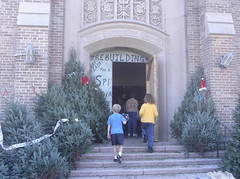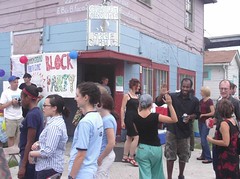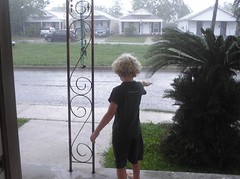|
Tuesday, December 19, 2006
hiatus
hi·a·tus [hahy-ey-tuhs]
–noun, plural -tus·es, -tus.
1. a break or interruption in the continuity of a work, series, action, etc.
2. a missing part; gap or lacuna: Scholars attempted to account for the hiatus in the medieval manuscript.
3. any gap or opening.
due to some stuff going on with me, the mama calendar is taking a year off.
I want to thank all of my contributors for their beautiful work, which I look forward to including in the 2008 edition. meanwhile, I'm spending time with my family, getting well and catching up on other work.
of course, all funds sent for pre-orders are being refunded!
and, if you're still shopping for a 2007 calendar, there are lots of options out there. one I really like is nikki mcclure's.
the website says out of stock today, but I picked one up for half off at whole foods just the other day...
I'd also like to check out heather cushman-dowdee's Hathor the Cow Goddess Calendar.
and hanging on my wall already is the completely wonderful louisiana festivals calendar made by julie posner.
hi·a·tus [hahy-ey-tuhs]
–noun, plural -tus·es, -tus.
1. a break or interruption in the continuity of a work, series, action, etc.
2. a missing part; gap or lacuna: Scholars attempted to account for the hiatus in the medieval manuscript.
3. any gap or opening.
due to some stuff going on with me, the mama calendar is taking a year off.
I want to thank all of my contributors for their beautiful work, which I look forward to including in the 2008 edition. meanwhile, I'm spending time with my family, getting well and catching up on other work.
of course, all funds sent for pre-orders are being refunded!
and, if you're still shopping for a 2007 calendar, there are lots of options out there. one I really like is nikki mcclure's.
the website says out of stock today, but I picked one up for half off at whole foods just the other day...
I'd also like to check out heather cushman-dowdee's Hathor the Cow Goddess Calendar.
and hanging on my wall already is the completely wonderful louisiana festivals calendar made by julie posner.
Saturday, December 16, 2006
Tuesday, November 28, 2006
Saturday, November 18, 2006
I'm glad you were born
from the writer's almanac:
It's the birthday of novelist and poet Margaret Atwood, born in Ottawa, Ontario (1939). Her father was an entomologist who spent every year from April to November studying insects at a forestry research station in northern Quebec. Atwood said, "At the age of six months, I was carried into the woods in a packsack, and this landscape became my hometown." She had no access to television or movies, and few children to play with. So she spent all her time exploring the woods and reading.
She only began to attend full-time school in Toronto when she was 11 years old. She wrote, "I was now faced with real life, in the form of other little girls—their prudery and snobbery, their Byzantine social life based on whispering and vicious gossip, and an inability to pick up earthworms without wriggling all over and making mewing noises like a kitten."
Atwood decided she wanted to be a writer at a time when there was almost no such thing as Canadian literature. There was actually a year in the early 1960s when a total of only five Canadian novels were published in the whole country. Her first novel, The Edible Woman, came out in 1969. The Handmaid's Tale became an international best-seller in 1985.
no wonder Cat's Eye rings so painfully true.
meanwhile, it's a good day. perfect weather and excellent yard saling: I got some big clunky brown clogs with buckles, 2 pair of zippered ankle boots, 2 pair of jeans that fit, assorted nice tops, an old point bar ballcap, 2 mini metal lunchboxes (1 boris & natasha, 1 monopoly), and the kids bought a 3rd rock from the sun video. I also bought a stack of books at the library sale.
right now the kids are howling with laughter at john lithgow.
from the writer's almanac:
It's the birthday of novelist and poet Margaret Atwood, born in Ottawa, Ontario (1939). Her father was an entomologist who spent every year from April to November studying insects at a forestry research station in northern Quebec. Atwood said, "At the age of six months, I was carried into the woods in a packsack, and this landscape became my hometown." She had no access to television or movies, and few children to play with. So she spent all her time exploring the woods and reading.
She only began to attend full-time school in Toronto when she was 11 years old. She wrote, "I was now faced with real life, in the form of other little girls—their prudery and snobbery, their Byzantine social life based on whispering and vicious gossip, and an inability to pick up earthworms without wriggling all over and making mewing noises like a kitten."
Atwood decided she wanted to be a writer at a time when there was almost no such thing as Canadian literature. There was actually a year in the early 1960s when a total of only five Canadian novels were published in the whole country. Her first novel, The Edible Woman, came out in 1969. The Handmaid's Tale became an international best-seller in 1985.
no wonder Cat's Eye rings so painfully true.
meanwhile, it's a good day. perfect weather and excellent yard saling: I got some big clunky brown clogs with buckles, 2 pair of zippered ankle boots, 2 pair of jeans that fit, assorted nice tops, an old point bar ballcap, 2 mini metal lunchboxes (1 boris & natasha, 1 monopoly), and the kids bought a 3rd rock from the sun video. I also bought a stack of books at the library sale.
right now the kids are howling with laughter at john lithgow.
Friday, November 03, 2006
Support the Latino Health Outreach Project in New Orleans
Healthcare providers working with LHOP yesterday morning were seeing patients dressed only in t-shirts and jeans, with inadequate socks. They are asking for donations of jackets, sweatshirts, mittens, gloves, hats and wool socks, with the request that all socks be bought new. Donations for LHOP can be sent to
the Common Ground Health Clinic at 1400 Teche Street, New Orleans, LA, 70114
Healthcare providers working with LHOP yesterday morning were seeing patients dressed only in t-shirts and jeans, with inadequate socks. They are asking for donations of jackets, sweatshirts, mittens, gloves, hats and wool socks, with the request that all socks be bought new. Donations for LHOP can be sent to
the Common Ground Health Clinic at 1400 Teche Street, New Orleans, LA, 70114
Wednesday, November 01, 2006
time
as I turned my calendar pages over this morning, I realized that it's time! time to make the calendar. so, people, mothers, fathers, partners, kids, friends & allies, send me your best stuff, by December 1, to the mama calendar coleen murphy PO box 741655 new orleans, LA 70174 coleen@bust.com
calendars will be available on or around December 20, 2006, for $12 a piece, payable by check, cash, money order or paypal. advance orders are what make the calendar project possible. ask about wholesale pricing for orders of ten or more.
here is what the cover of the 2006 edition looked like:
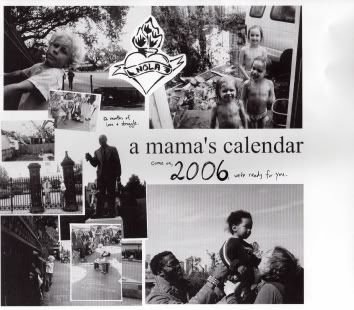
the mama calendar is a community building-consciousness raising resource by, of, about and for progressive, feminist, activist mothers and their families, friends & allies everywhere. it is a celebration and a call to action, a thing of beauty to last the year.
edited by coleen murphy, the calendar features photos of mamas, babies, children, dads, and friends, as well as a guide to mama-made zines, alternative parenting resources, recipes, recipes for revolution, great dates in radical mama herstory, and the work of numerous artist/activist/mamas. recent editions have featured ayun halliday, victoria law, laurel dykstra, sonja smith, trula breckenridge and heather cushman-dowdee, among others.
check back here periodically for the latest information on next year's edition.
as I turned my calendar pages over this morning, I realized that it's time! time to make the calendar. so, people, mothers, fathers, partners, kids, friends & allies, send me your best stuff, by December 1, to the mama calendar coleen murphy PO box 741655 new orleans, LA 70174 coleen@bust.com
calendars will be available on or around December 20, 2006, for $12 a piece, payable by check, cash, money order or paypal. advance orders are what make the calendar project possible. ask about wholesale pricing for orders of ten or more.
here is what the cover of the 2006 edition looked like:

the mama calendar is a community building-consciousness raising resource by, of, about and for progressive, feminist, activist mothers and their families, friends & allies everywhere. it is a celebration and a call to action, a thing of beauty to last the year.
edited by coleen murphy, the calendar features photos of mamas, babies, children, dads, and friends, as well as a guide to mama-made zines, alternative parenting resources, recipes, recipes for revolution, great dates in radical mama herstory, and the work of numerous artist/activist/mamas. recent editions have featured ayun halliday, victoria law, laurel dykstra, sonja smith, trula breckenridge and heather cushman-dowdee, among others.
check back here periodically for the latest information on next year's edition.
Friday, October 13, 2006
The Future Generation
a zine for subculture parents, kids, friends, & others
China's latest issue is out, brilliant & beautiful as ever:
Issue #15 "Raising Teenagers & other Adventures"
Inside:
Love and Freedom or What Happens when Revolutionary Teens Grow Up Have Teens of Their Own
Size Ten - by Lisa Peet
The Autistic Teenager - by Regina Walker
Bright Eyes - Kim Upton
You Want to Know the Truth? - Jamminmommy
My Mom-of-Teen stories - China Martens
Punk Parents of Teens
Changing Identities: rainbows to pansexuality
The True Life Story of Sex & the Single Mom
Eleven Good Things about having a 17 year old
Empty Nest
and more
Artwork by Lydia Prentis, Nathalie Jedynak, & Victoria Law
64 pages for $3
Contact/Order: China Martens, P.O. Box 4803 Baltimore, MD 21211
China410@hotmail.com
heres the first review, from Quimbys Bookstore:
As a social phenomenon, “punk parenting” seems to be gaining ground and is beating the hell out of “hippie parenting.” See, dad? I told you my generation was better! This is perhaps the most insightful, engaging, and well-rounded “punk parent” zine I have yet seen. --AB
available soon from Baltimore bookstores: Atomic Books, Normals, & Red Emmas
Contributor Copies and Trades will be send out shortly (Monday at latest)
a zine for subculture parents, kids, friends, & others
China's latest issue is out, brilliant & beautiful as ever:
Issue #15 "Raising Teenagers & other Adventures"
Inside:
Love and Freedom or What Happens when Revolutionary Teens Grow Up Have Teens of Their Own
Size Ten - by Lisa Peet
The Autistic Teenager - by Regina Walker
Bright Eyes - Kim Upton
You Want to Know the Truth? - Jamminmommy
My Mom-of-Teen stories - China Martens
Punk Parents of Teens
Changing Identities: rainbows to pansexuality
The True Life Story of Sex & the Single Mom
Eleven Good Things about having a 17 year old
Empty Nest
and more
Artwork by Lydia Prentis, Nathalie Jedynak, & Victoria Law
64 pages for $3
Contact/Order: China Martens, P.O. Box 4803 Baltimore, MD 21211
China410@hotmail.com
heres the first review, from Quimbys Bookstore:
As a social phenomenon, “punk parenting” seems to be gaining ground and is beating the hell out of “hippie parenting.” See, dad? I told you my generation was better! This is perhaps the most insightful, engaging, and well-rounded “punk parent” zine I have yet seen. --AB
available soon from Baltimore bookstores: Atomic Books, Normals, & Red Emmas
Contributor Copies and Trades will be send out shortly (Monday at latest)
Wednesday, October 11, 2006
for the record
oh, it's national coming out day! it always creeps up on me.
anyhow, let me just say, for the record, and in honor of the early 1990s, I'm here, I'm queer, get used to it.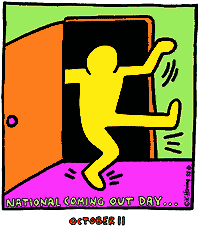
oh, it's national coming out day! it always creeps up on me.
anyhow, let me just say, for the record, and in honor of the early 1990s, I'm here, I'm queer, get used to it.

Saturday, October 07, 2006
Microcosm Zine Tour Hits New Orleans
When: Monday, October 09 2006 @ 07:00 PM CDT - 09:00PM
Where: Iron Rail Bookstore 511 Marigny at Decatur
Description: Thinkin, Stinkin, Rarely Drinkin Tour 2006
Pre New Orleans Bookfair Event
$3-$5 with meal
Dave Roche - reading about having Crohn's dsease and some new stuff
Joe Biel - Playing Four Short Videos
Joshua Ploeg - Vegan Chef, cooking up a gourmet vegan storm
Plus a few zine readings from locals
When: Monday, October 09 2006 @ 07:00 PM CDT - 09:00PM
Where: Iron Rail Bookstore 511 Marigny at Decatur
Description: Thinkin, Stinkin, Rarely Drinkin Tour 2006
Pre New Orleans Bookfair Event
$3-$5 with meal
Dave Roche - reading about having Crohn's dsease and some new stuff
Joe Biel - Playing Four Short Videos
Joshua Ploeg - Vegan Chef, cooking up a gourmet vegan storm
Plus a few zine readings from locals
Saturday, September 30, 2006
on the verge
of october, and deep in my own anniversary, reflecting on one year as a new orleans returnee.
I read over some of my writings from last september and october and the first thing I notice is the sleep issues. I very rarely have trouble sleeping at night anymore, or with waking up freaked out at the crack of dawn.
I'm also ready to get ready for the bookfair.
and decide on a halloween costume.
and putter around in my kitchen, baking good things to eat.
I'm pretty okay.
a million things are broken and wrong and outrageously unjust, but still, I'm okay.
of october, and deep in my own anniversary, reflecting on one year as a new orleans returnee.
I read over some of my writings from last september and october and the first thing I notice is the sleep issues. I very rarely have trouble sleeping at night anymore, or with waking up freaked out at the crack of dawn.
I'm also ready to get ready for the bookfair.
and decide on a halloween costume.
and putter around in my kitchen, baking good things to eat.
I'm pretty okay.
a million things are broken and wrong and outrageously unjust, but still, I'm okay.
Monday, September 11, 2006
Sunday, September 10, 2006
anniversaries
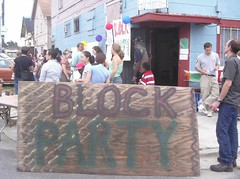
september06 043
Originally uploaded by khollean.
and last night in algiers...
it was one year ago yesterday that the common ground health clinic was founded, in the form of a first aid station that quickly evolved and continues to do so.
coral kids

september06 011
Originally uploaded by khollean.
last week I went to the aquarium for the first time since I don't know when; at least a year. it was weirdly empty of people but I guess that shouldn't be suprising in the here and now. anyway, the kids got into it. heh heh.
Saturday, August 26, 2006
new orleans checks in: then & now
The following paragraph from the past is remarkably right now for a lot of us. The piece after it, by Bill Quigley, is long, but that length comes from a thorough examination of the way things are in the city right now, and it's well worth reading.
Lafcadio Hearn, New Orleanian and author, writing to a friend in Cincinnati in 1870:
Times are not good here. The city is crumbling into ashes. It has been buried under a lava flood of taxes and frauds and maladministrations so that it has become only a study for archaeologists. Its condition is so bad that when I write about it, as I intend to do soon, nobody will believe I am telling the truth. But it is better to live here in sackcloth and ashes, than to own the whole state of Ohio.
Bill Quigley, August 2006:
Trying to Make It Home: New Orleans One Year After Katrina
Bernice Mosely is 82 and lives alone in New Orleans in
a shotgun double. On August 29, 2005, as Katrina hit
the Gulf Coast, the levees constructed by the U.S.
Corps of Engineers failed in five places and New
Orleans filled with water.
One year ago Ms. Mosely was on the second floor of her
neighborhood church. Days later, she was helicoptered
out. She was so dehydrated she spent eight days in a
hospital. Her next door neighbor, 89 years old,
stayed behind to care for his dog. He drowned in the
eight feet of floodwaters that covered their
neighborhood.
Ms. Mosely now lives in her half-gutted house. She
has no stove, no refrigerator, and no
air-conditioning. The bottom half of her walls have
been stripped of sheetrock and are bare wooden slats
from the floor halfway up the wall. Her food is
stored in a styrofoam cooler. Two small fans push the
hot air around.
Two plaster Madonnas are in her tiny well-kept front
yard. On a blazing hot summer day, Ms. Mosely used
her crutches to gingerly come down off her porch to
open the padlock on her fence. She has had hip and
knee replacement surgery. Ms. Mosely worked in a New
Orleans factory for over thirty years sewing uniforms.
When she retired she was making less than $4 an
hour. "Retirement benefits?" she laughs. She lives
off social security. Her house had never flooded
before. Because of her tight budget tight, Ms. Mosely
did not have flood insurance.
Thousands of people like Ms. Mosely are back in their
houses on the Gulf Coast. They are living in houses
that most people would consider, at best, still under
construction, or, at worst, uninhabitable. Like Ms.
Mosely, they are trying to make their damaged houses
into homes.
New Orleans is still in intensive care. If you have
seen recent television footage of New Orleans, you
probably have a picture of how bad our housing
situation is. What you cannot see is that the rest of
our institutions, our water, our electricity, our
healthcare, our jobs, our educational system, our
criminal justice systems – are all just as broken as
our housing. We remain in serious trouble. Like us,
you probably wonder where has the promised money gone?
Ms. Mosely, who lives in the upper ninth ward, does
not feel sorry for herself at all. "Lots of people
have it worse," she says. "You should see those
people in the Lower Ninth and in St. Bernard and in
the East. I am one of the lucky ones."
Housing
Hard as it is to believe, Ms. Mosely is right. Lots
of people do have it worse. Hundreds of thousands of
people from the Gulf Coast remain displaced. In New
Orleans alone over two hundred thousand people have
not been able to make it home.
Homeowners in Louisiana, like Ms. Mosely, have not yet
received a single dollar of federal housing rebuilding
assistance to rebuild their severely damaged houses
back into homes. Over 100,000 homeowners in
Louisiana are on a waiting list for billions in
federal rebuilding assistance through the Community
Development Block Grant (CDBG) program. So far, no
money has been distributed.
Renters, who comprised most of the people of New
Orleans before Katrina, are much worse off than
homeowners. New Orleans lost more than 43,000 rental
units to the storm. Rents have skyrocketed in the
undamaged parts of the area, pricing regular working
people out of the market. The official rate of
increase in rents is 39%. In lower income
neighborhoods, working people and the elderly report
rents are up much higher than that. Amy Liu of the
Brookings Institute said "Even people who are working
temporarily for the rebuilding effort are having
trouble finding housing."
Renters in Louisiana are not even scheduled to receive
assistance through the Louisiana CDBG program. Some
developers will receive assistance at some point, and
when they do, some apartments will be made available,
but that is years away.
In the face of the worst affordable housing shortage
since the end of the Civil War, the federal government
announced that it refused to allow thousands of
families to return to their public housing units and
was going to bulldoze 5000 apartments. Before
Katrina, over 5000 families lived in public housing –
88 percent women-headed households, nearly all African
American.
These policies end up with hundreds of thousands of
people still displaced from their homes. Though all
ages, incomes and races are displaced, some groups are
impacted much more than others. The working poor,
renters, moms with kids, African-Americans, the
elderly and disabled – all are suffering
disproportionately from displacement. Race, poverty,
age and physical ability are great indicators of who
has and who has made it home.
The statistics tell some of the story. The City of
New Orleans says it is half its pre-Katrina size –
around 225,000 people. But the U.S. Post Office
estimates that only about 170,000 people have returned
to the city and 400,000 people have not returned to
the metropolitan area. The local electricity company
reports only about 80,000 of its previous 190,000
customers have returned.
Texas also tells part of the story. It is difficult
to understand the impact of Katrina without
understanding the role of Texas – home to many of our
displaced. Houston officials say their city is still
home to about 150,000 storm evacuees – 90,000 in FEMA
assisted housing. Texas recently surveyed the
displaced and reported that over 250,000 displaced
people live in the state and 41 percent of these
households report income of less than $500 per month.
Eighty-one percent are black, 59 percent are still
jobless, most have at least one child at home, and
many have serious health issues.
Another 100,000 people displaced by Katrina are in
Georgia, more than 80,000 in metro Atlanta – most of
whom also need long-term housing and mental health
services.
In Louisiana, there are 73,000 families in FEMA
trailers. Most of these trailers are 240 square feet
of living space. More than 1600 families are still
waiting for trailers in St. Bernard Parish. FEMA
trailers did not arrive in the lower ninth ward until
June – while the displaced waited for water and
electricity to resume. Aloyd Edinburgh, 75, lives in
the lower ninth ward and just moved into a FEMA
trailer. His home flooded as did the homes of all
five of his children. "Everybody lost their homes,"
he told the Times-Picayune, "They just got trailers.
All are rebuilding. They all have mortgages. What
else are they going to do?"
Until challenged, FEMA barred reporters from talking
with people in FEMA trailer parks without prior
permission – forcing a reporter out of a trailer in
one park and residents back into their trailer in
another in order to stop interviews.
One person displaced into a FEMA village in Baton
Rouge has been organizing with her new neighbors. Air
conditioners in two trailers for the elderly have been
out for over two weeks, yet no one will fix them. The
contractor who ran the village has been terminated and
another one is coming – no one knows who. She tells
me, "My neighbors are dismayed that no one in the city
has stepped forward to speak for us. We are "gone."
Who will speak for us? Does anyone care?"
Trailers are visible signs of the displaced. Tens of
thousands of other displaced families are living in
apartments across the country month to month under
continuous threats of FEMA cutoffs.
Numbers say something. But please remember behind
every number, there is a Ms. Mosely. Tens of
thousands, hundreds of thousands, of people each with
a personal story like Ms. Mosely are struggling to
return, trying to make it home.
Water and Electricity
New Orleans continues to lose more water than it
uses. The Times-Picayune discovered that the local
water system has to pump over 130 million gallons a
day so that 50 million gallons will come out. The
rest runs away in thousands of leaks in broken water
lines, costing the water system $2000,000 a day. The
lack of water pressure, half that of other cities,
creates significant problems in consumption,
sanitation, air-conditioning, and fire prevention.
In the lower 9th ward, the water has still not been
certified as safe to drink – one year later.
Only half the homes in New Orleans have electricity.
Power outages are common as hundreds of millions of
dollars in repairs have not been made because Entergy
New Orleans is in bankruptcy. Entergy is asking for a
25 percent increase in rates to help it become
solvent. Yet Entergy New Orleans' parent company,
Entergy Corporation reported earnings of $282 million
last year on revenue of $2.6 billion.
Health and Healthcare
Early this month, on August 1, 2006, another Katrina
victim was found in her home in New Orleans, buried
under debris. The woman was the 28th person found
dead since March 2006. A total of 1577 died in
Louisiana as a result of Katrina.
A friend of mine, a lawyer with health insurance and
a family physician, went for an appointment recently
at 11am. The office was so crowded he had to sit out
in the hall on the floor to wait his turn for a seat
in the waiting room. Three hours later he met his
doctor. The doctor thought might have a gall stone.
The doctor tried to set up an ultrasound. None were
available. He ordered my friend to the emergency room
for an ultrasound. At 4pm my friend went to the
hospital emergency room, which was jammed with people:
stroke victims, young kids with injuries, people
brought in by the police. At 5am the next morning, my
friend finished his ultrasound and went home. If it
takes a lawyer with health insurance that long to get
medical attention, consider what poor people without
health insurance are up against.
Half the hospitals open before Katrina are still
closed. The state's biggest public healthcare
provider, Charity Hospital, remains closed and there
are no current plans to reopen it anytime soon.
Healthcare could actually get worse. Dr. Mark Peters,
board chair of the Metropolitan Hospital Council of
New Orleans said within the next two to three months,
"all the hospitals" will be looking seriously at
cutbacks. Why? Doctors and healthcare workers have
left and there is surging demand from the uninsured
who before Katrina went through now non-existent
public healthcare. There is a shortage of nurses.
Blue Cross Blue Shield officials reported "About
three-quarters of the physicians who had been
practicing in New Orleans are no longer submitting
claims."
There is no hospital at all in the city for
psychiatric patients. While the metropolitan area
had about 450 psychiatric beds before the storm, 80
are now available. The police are the first to
encounter those with mental illness. One recent
Friday afternoon, police dealt with two mental
patients – one was throwing bricks through a bar
window, the other was found wandering naked on the
interstate.
The elderly are particularly vulnerable. Over 70
percent of the deaths from Katrina were people over 60
years old. No one knows how many seniors have not
made it back home. Esther Bass, 69, told the New
York Times, after months of searching for a place to
come home to New Orleans, "If there are apartments, I
can't afford them. And they say there will be senior
centers, but they're still being built. They can't
even tell you what year they'll be finished." As of
late July 2006, most nursing homes in the 12 parish
Gulf Coast area of Louisiana are still not fully
prepared to evacuate residents in the face of a
hurricane.
The healthcare community has been rocked by the
arrest of a doctor and two nurses after the Louisiana
Attorney General accused them of intentionally ending
the lives of four patients trapped in a now-closed
local hospital. The accusations now go before a local
grand jury which is not expected to make a decision on
charges for several more months. The case is
complicated for several reasons. Most important is
that the doctor and nurses are regarded as some of the
most patient-oriented and caring people of the entire
hospital staff. It is undisputed that they worked
day and night to save hundreds of patients from the
hospital during the days it was without water,
electricity or food. Others say that entire hospital
and many others were abandoned by the government and
that is what the attorney general should be
investigating. The gravity of the charges, though,
is giving everyone in the community pause. This, like
so much else, will go on for years before there is any
resolution.
Jobs
Before Katrina, there were over 630,000 workers in
the metropolitan New Orleans area – now there are
slightly over 400,000. Over 18,000 businesses
suffered "catastrophic" damage in Louisiana. Nearly
one in four of the displaced workers is still
unemployed. Education and healthcare have lost the
most employees. Most cannot return because there is
little affordable housing, child care, public
transportation and public health care.
Women workers, especially African American women
workers, continue to bear the heaviest burden of harm
from the storm. The Institute for Women's Policy
Research reports that the percentage of women in the
New Orleans workforce has dropped. The number of
single mother families in New Orleans has dropped from
51,000 to 17,000. Low-income women remain displaced
because of the lack of affordable housing and
traditional discrimination against women in the
construction industry.
Tens of thousands of migrant workers, roughly half
undocumented, have come to the Gulf Coast to work in
the recovery. Many were recruited. Most workers
tell of being promised good wages and working
conditions and plenty of work. Some paid money up
front for the chance to come to the area to work.
Most of these promises were broken. A tour of the
area reveals many Latino workers live in houses
without electricity, other live out of cars. At
various places in the city whole families are living
in tents. Two recently released human rights reports
document the problems of these workers. Immigrant
workers are doing the dirtiest, most dangerous work,
in the worst working conditions. Toxic mold, lead
paint, fiberglass, and who knows what other chemicals
are part of daily work. Safety equipment is not
always provided. Day laborers, a new category of
workers in New Orleans, are harassed by the police and
periodic immigration raids. Wage theft is widespread
as employers often do not pay living wages, and
sometimes do not pay at all. Some of the powers try
to pit local workers against new arrivals – despite
the fact that our broken Gulf Coast clearly needs all
the workers we can get.
Public transportation to and from low-wage jobs is
more difficult. Over 200 more public transit
employees have been terminated – cutting employment
from over 1300 people pre-Katrina to about 700 now.
Single working parents seeking childcare are in
trouble. Before Katrina, New Orleans had 266 licensed
day care centers. Mississippi State University
surveyed the city in July 2006 and found 80 percent of
the day care centers and over 75 percent of the 1912
day care spots are gone. Only one-third of the Head
Start centers that were open pre-Katrina survived.
Public Education
Before Katrina, 56,000 students were enrolled in over
100 public schools in New Orleans. At the end of the
school year there were only 12,500. Right after the
storm, the local school board gave many of the best
public schools to charter groups. The State took over
almost all the rest. By the end of the school year,
four schools were operated by the pre-Katrina school
board, three by the State, and eighteen were new
charter schools.
After thirty-two years of collective bargaining, the
union contract with the New Orleans public school
teachers elapsed and was not renewed and 7500
employees were terminated.
For this academic year, no one knows for certain how
many students will enroll in New Orleans public
schools. Official estimates vary between a low of
22,000 and a high of 34,000. There will be five
traditional locally supervised public schools,
eighteen schools operated by the State, and
thirty-four charter schools. As of July 1, not a
single teacher had been hired for fifteen of the
state-run schools. As of August 9, 2006, the
Times-Picayune reported there are no staff at all
identified to educate students with discipline
problems or other educational issues that require
special attention.
Whatever the enrollment in the new public school
system is in the fall, it will not give an accurate
indication of how many children have returned. Why?
Many students in the public charter schools were in
private schools before the hurricane.
Criminal Legal System
Consider also our criminal legal system. Chaka
Davis was arrested on misdemeanor charges in October
2005 and jailed at the Greyhound station in New
Orleans in October of 2005. Under Louisiana law, he
was required to be formally charged within 30 days of
arrest or released from custody. Because of a filing
error he was lost in the system. He was never
charged, never went to court, and never saw a lawyer
in over 8 months – even though the maximum penalty for
conviction for one of his misdemeanors was only 6
months. His mother found him in an out of town jail
and brought his situation to the attention of the
public defenders. He was released the next day.
Crime is increasingly a problem. In July, New
Orleans lost almost as many people to murder as in
July of 2005, with only 40 percent of the population
back. There are many young people back in town while
their parents have not returned. State and local
officials called in the National Guard to patrol
lightly populated areas so local police could
concentrate on high-crime, low-income neighborhoods.
Arrests have soared, but the number of murders remain
high. Unfortunately, several of the National Guard
have been arrested for criminal behavior as well – two
for looting liquor from a home, two others for armed
robbery at a traffic stop.
Criminal Court District Judge Arthur Hunter has
declared the current criminal justice system shameful
and unconstitutional and promises to start releasing
inmates awaiting trial on recognizance bonds on the
one year anniversary of Katrina. The system is nearly
paralyzed by a backlog of over 6000 cases. There are
serious evidence problems because of resigned police
officers, displaced victims, displaced witnesses, and
flooded evidence rooms. The public defender system,
which was down to 4 trial attorneys for months, is
starting to rebuild.
"After 11 months of waiting, 11 months of meetings,
11 months of idle talk, 11 months without a sensible
recovery plan and 11 months tolerating those who have
the authority to solve, correct and fix the problem
but either refuse, fail or are just inept, then
necessary action must be taken to protect the
constitutional rights of people,' said Hunter.
In the suburbs across the lake, Sheriff Jack Strain
told the media on TV that he was going to protect his
jurisdiction from "thugs" and "trash" migrating from
closed public housing projects in New Orleans. He
went on to promise that every person who wore
"dreadlocks or che-wee hairstyles" could expect to be
stopped by law enforcement. The NAACP and the ACLU
called in the U.S. Justice Department and held a
revival-like rally at a small church just down the
road from the jail. Though the area is over 80
percent white, the small group promised to continue to
challenge injustice no matter how powerful the person
committing the injustice. Recently, the same law
enforcement people set up a roadblock and were
stopping only Latino people to check IDs and
insurance. I guess to prove they were not only
harassing black people?
Finally, a grand jury has started looking into
actions by other suburban police officers who blocked
a group of people, mostly black, from escaping the
floodwaters of New Orleans by walking across the
Mississippi River bridge. The suburban police forced
the crowd to flee back across the two mile bridge by
firing weapons into the air.
This is the criminal legal system in the New Orleans
area in 2006. None dare call it criminal justice.
International Human Rights
The Gulf Coast has gained new respect for
international human rights because they provide a more
appropriate way to look at what should be happening.
The fact that there is an international human right of
internally displaced people to return to their homes
and a responsibility on government to help is
heartening even though yet unfulfilled.
The United Nations has blasted the poor U.S. response
to Katrina. The UN Human Rights Committee in Geneva
accepted a report from Special Reporter Arjun Sengupta
who visited New Orleans in fall of 2005 and concluded:
"The Committee…remains concerned about information
that poor people, and in particular African-Americans,
were disadvantaged by the rescue and evacuation plans
implemented when Hurricane Katrina hit the United
States of America, and continue to be disadvantaged
under the reconstruction plans."
Asian tsunami relief workers who visited New Orleans
over the summer were shocked at the lack of recovery.
Somsook Boonyabancha, director of the Community
Organisations Development Institute in Thailand, told
Reuters she was shocked at the lack of progress in New
Orleans. "I'm surprised to see why the reconstruction
work is so slow, because this is supposed to be one of
the most rich and efficient countries in the world. It
is starting at such a slow speed, incredibly slow
speed."
Warnings to the Displaced
Local United Way officials see the lack of housing,
healthcare and jobs and conclude that low-income
people should seriously consider not returning to New
Orleans anytime soon.
United Way wrote: "Most of these people want to come
home, but if they do not have a recovery plan they
need to stay where they are. Some of these evacuees
think that they can come back and stay with families
and in a few weeks have a place of their own. But the
reality is that they may end up living with those
relatives for years. Sending people back without a
realistic plan may have serious consequences: the
crowding of families into small apartments/homes/FEMA
trailers is causing mental health problems – stress,
abuse, violence, and even death – and this problem is
going to get worse, not better. Also, when the
elderly (and others) are those returning and living in
these conditions, their health is impacted and then
the lack of medical facilities and hospital beds is a
problem. Again the result may be death….Basically if
an evacuee says they have a place to stay – like with
relatives – those communities will give them bus fare
back or pay for U-hauls. If an evacuee was a renter
here and they want to return they should be told to
plan on returning in 3-7 years, and in the meantime
stay there, get a job, and be much better off."
FEMA officials in Austin are also warning people
about returning to New Orleans. They wrote: "Before
you return….New Orleans is a changing place…you should
consider the conditions you may be returning to. Many
neighborhood schools will not be open by August. Your
children may have to travel some distance to get to
school…Grocery and supermarkets have been slow to
return to many neighborhoods. Sometimes there aren't
enough residents back in your neighborhood for a store
to open and be profitable. You may have to travel a
large distance to groceries. Walking to the store
might not be an option…If you or your family members
require regular medical attention, or if you are
pregnant or nursing, the services you received before
the storm may be scattered and in very different and
distant locations. Depending on your medical needs,
you may have to drive across the river or even as far
away as Baton Rouge…If you or your family members have
allergies, remember that there is lots of dust and
mold still in the city. While you may have suffered
from allergies before the storm, please consider that
being in the city will only worsen your allergies. If
you have asthma, other respiratory or cardiac
conditions, or immune system problems, you would be
safer staying out of flooded areas due to the mold,
particles and dust in the air. If you must return to
the city, wear an approved respirator when working in
moldy or dusty areas. …Additionally, police, fire and
emergency personnel are stretched to their limits…If
you own a car, gas and service stations are limited in
many areas. You may need to purchase a gas can in the
event you cannot get gas near your home…Public
transportation (busses) are also limited and do not
operate in all areas….Available and affordable housing
is extremely rare. Waiting lists for apartments are
as large as 300 on the list, depending on how many
bedrooms you need. Living inside your home could be
dangerous if mold has set in of if your utilities are
not in top working condition…Living in New Orleans may
be easier said than done until we have fully recovered
from the storm."
This is New Orleans, one year after Katrina.
Where Did the Money Go?
Everyone who visits New Orleans asks the same
question that locals ask – where is the money?
Congress reportedly appropriated over $100 billion to
rebuild the Gulf Coast. Over $50 billion was
allocated to temporary and long-term housing. Just
under $30 billion was for emergency response and
Department of Defense spending. Over $18 billion was
for State and local response and the rebuilding of
infrastructure. $3.6 billion was for health, social
services and job training and $3.2 for non-housing
cash assistance. $1.9 billion was allocated for
education and $1.2 billion for agriculture.
One hour in New Orleans shows the check must still be
in the mail.
Not a single dollar in federal housing rehab money has
made it into a hand in Louisiana. Though Congress has
allocated nearly $10 billion in Community Development
Block Grants, the State of Louisiana is still testing
the program and has not yet distributed dollar number
one.
A lot of media attention has gone to the prosecution
of people who wrongfully claimed benefits of $2000 or
more after the storm. Their fraud is despicable. It
harms those who are still waiting for assistance from
FEMA.
But, be clear - these little $2000 thieves are minnows
swimming on the surface. There are many big savage
sharks below. Congress and the national media have
so far been frustrated in their quest to get real
answers to where the millions and billions went. How
much was actually spent on FEMA trailers? How much
did the big contractors take off the top and then
subcontract out the work? Who were the subcontractors
for the multi-million dollar debris removal and
reconstruction contracts?
As Corpwatch says in their recent report, "Many of the
same 'disaster profiteers' and government agencies
that mishandled the reconstruction of Afghanistan and
Iraq are responsible for the failure of
'reconstruction' of the Gulf Coast region. The Army
Corps, Bechtel and Halliburton are using the very same
'contract vehicles' in the Gulf Coast as they did in
Afghanistan and Iraq. These are 'indefinite delivery,
indefinite quantity' open-ended 'contingency'
contracts that are being abused by the contractors on
the Gulf Coast to squeeze out local companies. These
are also 'cost-plus' contracts that allow them to
collect a profit on everything they spend, which is an
incentive to overspend."
We do know billions of dollars in no-bid FEMA
contracts went to Bechtel Corporation, the Shaw Group,
CH2M Hill, and Fluor immediately after Katrina hit.
Riley Bechtel, CEO of Bechtel Corporation, served on
President Bush's Export Council during 2003-2004. A
lobbyist for the Shaw Group, Joe Allbaugh, is a former
FEMA Director and friend of President Bush. The
President and Group Chief Executive of the
International Group at CH2MHill is Robert Card,
appointed by President Bush as undersecretary to the
US Department of Energy until 2004. Card also worked
at CH2M Hill before signing up with President Bush.
Fluor, whose work in Iraq was slowing down, is one of
the big winners of FEMA work and its stock is up 65
percent since it started Katrina work.
Senator Byron Dorgan of North Dakota has raised many
protests and questions over inflated prices. "It is
hard to overstate the incompetence involved in all of
these contracts – we have repeatedly asked them for
information and you get nothing." Republican U.S.
Representative Charles Bustany, who represents an area
heavily damaged by Hurricane Rita, asked FEMA for
reasons why the decision was made to stop funding 100
percent of the cost of debris removal in his district.
FEMA refused to tell him. He then filed a Freedom of
Information request to get the information, and was
again refused. When he asked to appeal their denial,
he was told that there were many appeals ahead of his
and he would have to wait.
If a US Senator and a local U.S. Republican
Representative cannot get answers from FEMA, how much
accountability can the people of the Gulf Coast
expect? There are many other examples of fraud, waste
and patronage.
How did a company that did not own a truck get a
contract for debris removal worth hundreds of millions
of dollars? The Miami Herald reported that the single
biggest receiver of early Katrina federal contracts
was Ashbritt, Inc. of Pompano Beach, FL, which
received over $579 million in contracts for debris
removal in Mississippi from Army Corps of Engineers.
The paper reported that the company does not own a
single dumptruck! All they do is subcontract out the
work. Ashbritt, however, had recently dumped $40,000
into the lobbying firm of Barbour, Griffith & Rogers,
which had been run by Mississippi Governor and former
National GOP Chair Haley Barbour. The owners of
Ashbritt also trucked $50,000 over to the Republican
National Committee in 2004.
How did a company that filed for bankruptcy the year
before and was not licensed to build trailers get a
$200 million contract for trailers? Circle B
Enterprises of Georgia was awarded $287 million in
contracts by FEMA for temporary housing. At the time,
that was the seventh highest award of Katrina money in
the country. According to the Washington Post, Circle
B was not even being licensed to build homes in its
own state of Georgia and filed for bankruptcy in 2003.
The company does not even have a website.
FEMA spent $7 million to build a park for 198
trailers in Morgan City Louisiana – almost 2 hours
away from New Orleans. Construction was completed in
April. Three months later only 20 of the trailers
were occupied. One displaced New Orleans resident who
lives there has to walk three miles to the nearest
grocery.
Hurricanes are now a booming billion dollar business.
No wonder there is a National Hurricane Conference
for private companies to show off their wares – from
RVs to portable cell phone towers to port-a-potties.
One long time provider was quoted by the Miami Herald
at the conference that there are all kinds of new
people in the field - 'Some folks here said, `Man,
this is huge business; this is my new business. I'm
not in the landscaping business anymore, I'm going to
be a hurricane debris contractor.' "
On the local level, we are not any better. One year
after Katrina the City of New Orleans still does not
have a comprehensive rebuilding plan. The first plan
by advisors to the Mayor was shelved before the
election. A city council plan was then started and
the state and federal government mandated yet another
process that may or may not include some of the
recommendations of the prior two processes. One of
the early advisors from the Urban Land Institute, John
McIlwain, blasted the delays in late July. "It's
virtually a city with a city administration and its
worse than ever…You need a politician, a leader that
is willing to make tough decisions and articulate to
people why these decisions are made, which means
everyone is not going to be happy." Without major
changes at City Hall the City will have miles of
neglected neighborhoods for decades. "We're talking
Dresden after World War II."
Signs of Hope
Despite the tragedies that continue to plague our
Gulf Coast, there is hope. Between the rocks of
hardship, green life continues to sprout defiantly.
Fifteen feet of water washed through Dr. Martin
Luther King, Jr. Elementary School for Science and
Technology in the lower 9th Ward. When people were
finally able to get into the building, the bodies of
fish were found on the second floor. Parents and over
90% of the teachers organized a grass-roots effort to
put their school back together. Their first attempts
to gut and repair the school by locals and volunteers
from Common Ground were temporarily stopped by local
school officials and the police. Even after the
gutting was allowed to resume, the community was told
that the school could not reopen due to insufficient
water pressure in the neighborhood. But the teachers
and parents are pressing ahead anyway in a temporary
location until they can get back in their school.
Assistant Principal Joseph Recasner told the
Times-Picayune: "Rebuilding our school says this is
a very special community, tied together by more than
location, but by spirituality, by bloodlines, and by a
desire to come back."
New Orleans is fortunate to have a working newspaper
again. The Times-Picayune won a well-deserved
Pulitzer for its Katrina coverage. Its staff
continues to provide quality documentation of the Gulf
Coast region's efforts to repair and rebuild.
The New Orleans Vietnamese people continue to inspire
us. They were among the very first group back and
they have joined forces to care for their elders,
rebuild their community church, and work together in a
most cooperative manner to resurrect their community.
Recently they took legal and direct action to
successfully stop the placement of a gigantic landfill
right next to their community. Their determination
and sense of community-building is a good model for us
all.
The only Republican running for Congress in New
Orleans is blasting President Bush over failed Katrina
promises. Joe Lavigne is running radio ads saying,
"Sadly, George Bush has forgotten us. He's spending
too much time and money on Iraq and not enough living
up to his promise to rebuild New Orleans. His
priorities are wrong. I'm running for Congress to
hold President Bush accountable." Maybe other
Republicans will join in.
Tens of thousands of volunteers from every walk of
life have joined with the people of the Gulf Coast to
help repair and rebuild. Lawyers are giving free help
to Katrina victims who need legal help to rebuild
their homes. Medical personnel staff free clinics.
Thousands of college, high school and even some grade
school students have traveled to the area to help
families gut their devastated homes. Churches,
temples, and mosques from across the world have joined
with sisters and brothers in New Orleans to repair and
rebuild.
Despite open attempts to divide them, black and brown
and white and yellow workers have started to talk to
each other. Small groups have started to work
together to fight for living wages and safe jobs for
all workers. Thousands came together for a rally for
respectful treatment for Latino and immigrant workers.
Seasoned civil rights activists welcomed the new
movement and pledged to work together.
Ultimately, the people of the Gulf Coast are the
greatest sign of hope. Despite setbacks that people
in the US rarely suffer, people continue to help each
other and fight for their right to return home and the
right to live in the city they love.
On Sunday morning, a 70 year old woman told a friend
where her children are. "They are all scattered," she
sighed. "One is in Connecticut, one in Rhode Island,
one in Austin." When he asked about her, she said,
"Me? I am in Texas right now. I am back here to
visit my 93 year old mother and go to the second line
of Black Men of Labor on Labor Day. But I'm coming
back. Yes indeed. I will return. I'm coming back."
Bill is a human rights lawyer and
law professor at Loyola University New Orleans. You
can reach him at Quigley@loyno.edu For more
information see www.justiceforneworleans.org
The following paragraph from the past is remarkably right now for a lot of us. The piece after it, by Bill Quigley, is long, but that length comes from a thorough examination of the way things are in the city right now, and it's well worth reading.
Lafcadio Hearn, New Orleanian and author, writing to a friend in Cincinnati in 1870:
Times are not good here. The city is crumbling into ashes. It has been buried under a lava flood of taxes and frauds and maladministrations so that it has become only a study for archaeologists. Its condition is so bad that when I write about it, as I intend to do soon, nobody will believe I am telling the truth. But it is better to live here in sackcloth and ashes, than to own the whole state of Ohio.
Bill Quigley, August 2006:
Trying to Make It Home: New Orleans One Year After Katrina
Bernice Mosely is 82 and lives alone in New Orleans in
a shotgun double. On August 29, 2005, as Katrina hit
the Gulf Coast, the levees constructed by the U.S.
Corps of Engineers failed in five places and New
Orleans filled with water.
One year ago Ms. Mosely was on the second floor of her
neighborhood church. Days later, she was helicoptered
out. She was so dehydrated she spent eight days in a
hospital. Her next door neighbor, 89 years old,
stayed behind to care for his dog. He drowned in the
eight feet of floodwaters that covered their
neighborhood.
Ms. Mosely now lives in her half-gutted house. She
has no stove, no refrigerator, and no
air-conditioning. The bottom half of her walls have
been stripped of sheetrock and are bare wooden slats
from the floor halfway up the wall. Her food is
stored in a styrofoam cooler. Two small fans push the
hot air around.
Two plaster Madonnas are in her tiny well-kept front
yard. On a blazing hot summer day, Ms. Mosely used
her crutches to gingerly come down off her porch to
open the padlock on her fence. She has had hip and
knee replacement surgery. Ms. Mosely worked in a New
Orleans factory for over thirty years sewing uniforms.
When she retired she was making less than $4 an
hour. "Retirement benefits?" she laughs. She lives
off social security. Her house had never flooded
before. Because of her tight budget tight, Ms. Mosely
did not have flood insurance.
Thousands of people like Ms. Mosely are back in their
houses on the Gulf Coast. They are living in houses
that most people would consider, at best, still under
construction, or, at worst, uninhabitable. Like Ms.
Mosely, they are trying to make their damaged houses
into homes.
New Orleans is still in intensive care. If you have
seen recent television footage of New Orleans, you
probably have a picture of how bad our housing
situation is. What you cannot see is that the rest of
our institutions, our water, our electricity, our
healthcare, our jobs, our educational system, our
criminal justice systems – are all just as broken as
our housing. We remain in serious trouble. Like us,
you probably wonder where has the promised money gone?
Ms. Mosely, who lives in the upper ninth ward, does
not feel sorry for herself at all. "Lots of people
have it worse," she says. "You should see those
people in the Lower Ninth and in St. Bernard and in
the East. I am one of the lucky ones."
Housing
Hard as it is to believe, Ms. Mosely is right. Lots
of people do have it worse. Hundreds of thousands of
people from the Gulf Coast remain displaced. In New
Orleans alone over two hundred thousand people have
not been able to make it home.
Homeowners in Louisiana, like Ms. Mosely, have not yet
received a single dollar of federal housing rebuilding
assistance to rebuild their severely damaged houses
back into homes. Over 100,000 homeowners in
Louisiana are on a waiting list for billions in
federal rebuilding assistance through the Community
Development Block Grant (CDBG) program. So far, no
money has been distributed.
Renters, who comprised most of the people of New
Orleans before Katrina, are much worse off than
homeowners. New Orleans lost more than 43,000 rental
units to the storm. Rents have skyrocketed in the
undamaged parts of the area, pricing regular working
people out of the market. The official rate of
increase in rents is 39%. In lower income
neighborhoods, working people and the elderly report
rents are up much higher than that. Amy Liu of the
Brookings Institute said "Even people who are working
temporarily for the rebuilding effort are having
trouble finding housing."
Renters in Louisiana are not even scheduled to receive
assistance through the Louisiana CDBG program. Some
developers will receive assistance at some point, and
when they do, some apartments will be made available,
but that is years away.
In the face of the worst affordable housing shortage
since the end of the Civil War, the federal government
announced that it refused to allow thousands of
families to return to their public housing units and
was going to bulldoze 5000 apartments. Before
Katrina, over 5000 families lived in public housing –
88 percent women-headed households, nearly all African
American.
These policies end up with hundreds of thousands of
people still displaced from their homes. Though all
ages, incomes and races are displaced, some groups are
impacted much more than others. The working poor,
renters, moms with kids, African-Americans, the
elderly and disabled – all are suffering
disproportionately from displacement. Race, poverty,
age and physical ability are great indicators of who
has and who has made it home.
The statistics tell some of the story. The City of
New Orleans says it is half its pre-Katrina size –
around 225,000 people. But the U.S. Post Office
estimates that only about 170,000 people have returned
to the city and 400,000 people have not returned to
the metropolitan area. The local electricity company
reports only about 80,000 of its previous 190,000
customers have returned.
Texas also tells part of the story. It is difficult
to understand the impact of Katrina without
understanding the role of Texas – home to many of our
displaced. Houston officials say their city is still
home to about 150,000 storm evacuees – 90,000 in FEMA
assisted housing. Texas recently surveyed the
displaced and reported that over 250,000 displaced
people live in the state and 41 percent of these
households report income of less than $500 per month.
Eighty-one percent are black, 59 percent are still
jobless, most have at least one child at home, and
many have serious health issues.
Another 100,000 people displaced by Katrina are in
Georgia, more than 80,000 in metro Atlanta – most of
whom also need long-term housing and mental health
services.
In Louisiana, there are 73,000 families in FEMA
trailers. Most of these trailers are 240 square feet
of living space. More than 1600 families are still
waiting for trailers in St. Bernard Parish. FEMA
trailers did not arrive in the lower ninth ward until
June – while the displaced waited for water and
electricity to resume. Aloyd Edinburgh, 75, lives in
the lower ninth ward and just moved into a FEMA
trailer. His home flooded as did the homes of all
five of his children. "Everybody lost their homes,"
he told the Times-Picayune, "They just got trailers.
All are rebuilding. They all have mortgages. What
else are they going to do?"
Until challenged, FEMA barred reporters from talking
with people in FEMA trailer parks without prior
permission – forcing a reporter out of a trailer in
one park and residents back into their trailer in
another in order to stop interviews.
One person displaced into a FEMA village in Baton
Rouge has been organizing with her new neighbors. Air
conditioners in two trailers for the elderly have been
out for over two weeks, yet no one will fix them. The
contractor who ran the village has been terminated and
another one is coming – no one knows who. She tells
me, "My neighbors are dismayed that no one in the city
has stepped forward to speak for us. We are "gone."
Who will speak for us? Does anyone care?"
Trailers are visible signs of the displaced. Tens of
thousands of other displaced families are living in
apartments across the country month to month under
continuous threats of FEMA cutoffs.
Numbers say something. But please remember behind
every number, there is a Ms. Mosely. Tens of
thousands, hundreds of thousands, of people each with
a personal story like Ms. Mosely are struggling to
return, trying to make it home.
Water and Electricity
New Orleans continues to lose more water than it
uses. The Times-Picayune discovered that the local
water system has to pump over 130 million gallons a
day so that 50 million gallons will come out. The
rest runs away in thousands of leaks in broken water
lines, costing the water system $2000,000 a day. The
lack of water pressure, half that of other cities,
creates significant problems in consumption,
sanitation, air-conditioning, and fire prevention.
In the lower 9th ward, the water has still not been
certified as safe to drink – one year later.
Only half the homes in New Orleans have electricity.
Power outages are common as hundreds of millions of
dollars in repairs have not been made because Entergy
New Orleans is in bankruptcy. Entergy is asking for a
25 percent increase in rates to help it become
solvent. Yet Entergy New Orleans' parent company,
Entergy Corporation reported earnings of $282 million
last year on revenue of $2.6 billion.
Health and Healthcare
Early this month, on August 1, 2006, another Katrina
victim was found in her home in New Orleans, buried
under debris. The woman was the 28th person found
dead since March 2006. A total of 1577 died in
Louisiana as a result of Katrina.
A friend of mine, a lawyer with health insurance and
a family physician, went for an appointment recently
at 11am. The office was so crowded he had to sit out
in the hall on the floor to wait his turn for a seat
in the waiting room. Three hours later he met his
doctor. The doctor thought might have a gall stone.
The doctor tried to set up an ultrasound. None were
available. He ordered my friend to the emergency room
for an ultrasound. At 4pm my friend went to the
hospital emergency room, which was jammed with people:
stroke victims, young kids with injuries, people
brought in by the police. At 5am the next morning, my
friend finished his ultrasound and went home. If it
takes a lawyer with health insurance that long to get
medical attention, consider what poor people without
health insurance are up against.
Half the hospitals open before Katrina are still
closed. The state's biggest public healthcare
provider, Charity Hospital, remains closed and there
are no current plans to reopen it anytime soon.
Healthcare could actually get worse. Dr. Mark Peters,
board chair of the Metropolitan Hospital Council of
New Orleans said within the next two to three months,
"all the hospitals" will be looking seriously at
cutbacks. Why? Doctors and healthcare workers have
left and there is surging demand from the uninsured
who before Katrina went through now non-existent
public healthcare. There is a shortage of nurses.
Blue Cross Blue Shield officials reported "About
three-quarters of the physicians who had been
practicing in New Orleans are no longer submitting
claims."
There is no hospital at all in the city for
psychiatric patients. While the metropolitan area
had about 450 psychiatric beds before the storm, 80
are now available. The police are the first to
encounter those with mental illness. One recent
Friday afternoon, police dealt with two mental
patients – one was throwing bricks through a bar
window, the other was found wandering naked on the
interstate.
The elderly are particularly vulnerable. Over 70
percent of the deaths from Katrina were people over 60
years old. No one knows how many seniors have not
made it back home. Esther Bass, 69, told the New
York Times, after months of searching for a place to
come home to New Orleans, "If there are apartments, I
can't afford them. And they say there will be senior
centers, but they're still being built. They can't
even tell you what year they'll be finished." As of
late July 2006, most nursing homes in the 12 parish
Gulf Coast area of Louisiana are still not fully
prepared to evacuate residents in the face of a
hurricane.
The healthcare community has been rocked by the
arrest of a doctor and two nurses after the Louisiana
Attorney General accused them of intentionally ending
the lives of four patients trapped in a now-closed
local hospital. The accusations now go before a local
grand jury which is not expected to make a decision on
charges for several more months. The case is
complicated for several reasons. Most important is
that the doctor and nurses are regarded as some of the
most patient-oriented and caring people of the entire
hospital staff. It is undisputed that they worked
day and night to save hundreds of patients from the
hospital during the days it was without water,
electricity or food. Others say that entire hospital
and many others were abandoned by the government and
that is what the attorney general should be
investigating. The gravity of the charges, though,
is giving everyone in the community pause. This, like
so much else, will go on for years before there is any
resolution.
Jobs
Before Katrina, there were over 630,000 workers in
the metropolitan New Orleans area – now there are
slightly over 400,000. Over 18,000 businesses
suffered "catastrophic" damage in Louisiana. Nearly
one in four of the displaced workers is still
unemployed. Education and healthcare have lost the
most employees. Most cannot return because there is
little affordable housing, child care, public
transportation and public health care.
Women workers, especially African American women
workers, continue to bear the heaviest burden of harm
from the storm. The Institute for Women's Policy
Research reports that the percentage of women in the
New Orleans workforce has dropped. The number of
single mother families in New Orleans has dropped from
51,000 to 17,000. Low-income women remain displaced
because of the lack of affordable housing and
traditional discrimination against women in the
construction industry.
Tens of thousands of migrant workers, roughly half
undocumented, have come to the Gulf Coast to work in
the recovery. Many were recruited. Most workers
tell of being promised good wages and working
conditions and plenty of work. Some paid money up
front for the chance to come to the area to work.
Most of these promises were broken. A tour of the
area reveals many Latino workers live in houses
without electricity, other live out of cars. At
various places in the city whole families are living
in tents. Two recently released human rights reports
document the problems of these workers. Immigrant
workers are doing the dirtiest, most dangerous work,
in the worst working conditions. Toxic mold, lead
paint, fiberglass, and who knows what other chemicals
are part of daily work. Safety equipment is not
always provided. Day laborers, a new category of
workers in New Orleans, are harassed by the police and
periodic immigration raids. Wage theft is widespread
as employers often do not pay living wages, and
sometimes do not pay at all. Some of the powers try
to pit local workers against new arrivals – despite
the fact that our broken Gulf Coast clearly needs all
the workers we can get.
Public transportation to and from low-wage jobs is
more difficult. Over 200 more public transit
employees have been terminated – cutting employment
from over 1300 people pre-Katrina to about 700 now.
Single working parents seeking childcare are in
trouble. Before Katrina, New Orleans had 266 licensed
day care centers. Mississippi State University
surveyed the city in July 2006 and found 80 percent of
the day care centers and over 75 percent of the 1912
day care spots are gone. Only one-third of the Head
Start centers that were open pre-Katrina survived.
Public Education
Before Katrina, 56,000 students were enrolled in over
100 public schools in New Orleans. At the end of the
school year there were only 12,500. Right after the
storm, the local school board gave many of the best
public schools to charter groups. The State took over
almost all the rest. By the end of the school year,
four schools were operated by the pre-Katrina school
board, three by the State, and eighteen were new
charter schools.
After thirty-two years of collective bargaining, the
union contract with the New Orleans public school
teachers elapsed and was not renewed and 7500
employees were terminated.
For this academic year, no one knows for certain how
many students will enroll in New Orleans public
schools. Official estimates vary between a low of
22,000 and a high of 34,000. There will be five
traditional locally supervised public schools,
eighteen schools operated by the State, and
thirty-four charter schools. As of July 1, not a
single teacher had been hired for fifteen of the
state-run schools. As of August 9, 2006, the
Times-Picayune reported there are no staff at all
identified to educate students with discipline
problems or other educational issues that require
special attention.
Whatever the enrollment in the new public school
system is in the fall, it will not give an accurate
indication of how many children have returned. Why?
Many students in the public charter schools were in
private schools before the hurricane.
Criminal Legal System
Consider also our criminal legal system. Chaka
Davis was arrested on misdemeanor charges in October
2005 and jailed at the Greyhound station in New
Orleans in October of 2005. Under Louisiana law, he
was required to be formally charged within 30 days of
arrest or released from custody. Because of a filing
error he was lost in the system. He was never
charged, never went to court, and never saw a lawyer
in over 8 months – even though the maximum penalty for
conviction for one of his misdemeanors was only 6
months. His mother found him in an out of town jail
and brought his situation to the attention of the
public defenders. He was released the next day.
Crime is increasingly a problem. In July, New
Orleans lost almost as many people to murder as in
July of 2005, with only 40 percent of the population
back. There are many young people back in town while
their parents have not returned. State and local
officials called in the National Guard to patrol
lightly populated areas so local police could
concentrate on high-crime, low-income neighborhoods.
Arrests have soared, but the number of murders remain
high. Unfortunately, several of the National Guard
have been arrested for criminal behavior as well – two
for looting liquor from a home, two others for armed
robbery at a traffic stop.
Criminal Court District Judge Arthur Hunter has
declared the current criminal justice system shameful
and unconstitutional and promises to start releasing
inmates awaiting trial on recognizance bonds on the
one year anniversary of Katrina. The system is nearly
paralyzed by a backlog of over 6000 cases. There are
serious evidence problems because of resigned police
officers, displaced victims, displaced witnesses, and
flooded evidence rooms. The public defender system,
which was down to 4 trial attorneys for months, is
starting to rebuild.
"After 11 months of waiting, 11 months of meetings,
11 months of idle talk, 11 months without a sensible
recovery plan and 11 months tolerating those who have
the authority to solve, correct and fix the problem
but either refuse, fail or are just inept, then
necessary action must be taken to protect the
constitutional rights of people,' said Hunter.
In the suburbs across the lake, Sheriff Jack Strain
told the media on TV that he was going to protect his
jurisdiction from "thugs" and "trash" migrating from
closed public housing projects in New Orleans. He
went on to promise that every person who wore
"dreadlocks or che-wee hairstyles" could expect to be
stopped by law enforcement. The NAACP and the ACLU
called in the U.S. Justice Department and held a
revival-like rally at a small church just down the
road from the jail. Though the area is over 80
percent white, the small group promised to continue to
challenge injustice no matter how powerful the person
committing the injustice. Recently, the same law
enforcement people set up a roadblock and were
stopping only Latino people to check IDs and
insurance. I guess to prove they were not only
harassing black people?
Finally, a grand jury has started looking into
actions by other suburban police officers who blocked
a group of people, mostly black, from escaping the
floodwaters of New Orleans by walking across the
Mississippi River bridge. The suburban police forced
the crowd to flee back across the two mile bridge by
firing weapons into the air.
This is the criminal legal system in the New Orleans
area in 2006. None dare call it criminal justice.
International Human Rights
The Gulf Coast has gained new respect for
international human rights because they provide a more
appropriate way to look at what should be happening.
The fact that there is an international human right of
internally displaced people to return to their homes
and a responsibility on government to help is
heartening even though yet unfulfilled.
The United Nations has blasted the poor U.S. response
to Katrina. The UN Human Rights Committee in Geneva
accepted a report from Special Reporter Arjun Sengupta
who visited New Orleans in fall of 2005 and concluded:
"The Committee…remains concerned about information
that poor people, and in particular African-Americans,
were disadvantaged by the rescue and evacuation plans
implemented when Hurricane Katrina hit the United
States of America, and continue to be disadvantaged
under the reconstruction plans."
Asian tsunami relief workers who visited New Orleans
over the summer were shocked at the lack of recovery.
Somsook Boonyabancha, director of the Community
Organisations Development Institute in Thailand, told
Reuters she was shocked at the lack of progress in New
Orleans. "I'm surprised to see why the reconstruction
work is so slow, because this is supposed to be one of
the most rich and efficient countries in the world. It
is starting at such a slow speed, incredibly slow
speed."
Warnings to the Displaced
Local United Way officials see the lack of housing,
healthcare and jobs and conclude that low-income
people should seriously consider not returning to New
Orleans anytime soon.
United Way wrote: "Most of these people want to come
home, but if they do not have a recovery plan they
need to stay where they are. Some of these evacuees
think that they can come back and stay with families
and in a few weeks have a place of their own. But the
reality is that they may end up living with those
relatives for years. Sending people back without a
realistic plan may have serious consequences: the
crowding of families into small apartments/homes/FEMA
trailers is causing mental health problems – stress,
abuse, violence, and even death – and this problem is
going to get worse, not better. Also, when the
elderly (and others) are those returning and living in
these conditions, their health is impacted and then
the lack of medical facilities and hospital beds is a
problem. Again the result may be death….Basically if
an evacuee says they have a place to stay – like with
relatives – those communities will give them bus fare
back or pay for U-hauls. If an evacuee was a renter
here and they want to return they should be told to
plan on returning in 3-7 years, and in the meantime
stay there, get a job, and be much better off."
FEMA officials in Austin are also warning people
about returning to New Orleans. They wrote: "Before
you return….New Orleans is a changing place…you should
consider the conditions you may be returning to. Many
neighborhood schools will not be open by August. Your
children may have to travel some distance to get to
school…Grocery and supermarkets have been slow to
return to many neighborhoods. Sometimes there aren't
enough residents back in your neighborhood for a store
to open and be profitable. You may have to travel a
large distance to groceries. Walking to the store
might not be an option…If you or your family members
require regular medical attention, or if you are
pregnant or nursing, the services you received before
the storm may be scattered and in very different and
distant locations. Depending on your medical needs,
you may have to drive across the river or even as far
away as Baton Rouge…If you or your family members have
allergies, remember that there is lots of dust and
mold still in the city. While you may have suffered
from allergies before the storm, please consider that
being in the city will only worsen your allergies. If
you have asthma, other respiratory or cardiac
conditions, or immune system problems, you would be
safer staying out of flooded areas due to the mold,
particles and dust in the air. If you must return to
the city, wear an approved respirator when working in
moldy or dusty areas. …Additionally, police, fire and
emergency personnel are stretched to their limits…If
you own a car, gas and service stations are limited in
many areas. You may need to purchase a gas can in the
event you cannot get gas near your home…Public
transportation (busses) are also limited and do not
operate in all areas….Available and affordable housing
is extremely rare. Waiting lists for apartments are
as large as 300 on the list, depending on how many
bedrooms you need. Living inside your home could be
dangerous if mold has set in of if your utilities are
not in top working condition…Living in New Orleans may
be easier said than done until we have fully recovered
from the storm."
This is New Orleans, one year after Katrina.
Where Did the Money Go?
Everyone who visits New Orleans asks the same
question that locals ask – where is the money?
Congress reportedly appropriated over $100 billion to
rebuild the Gulf Coast. Over $50 billion was
allocated to temporary and long-term housing. Just
under $30 billion was for emergency response and
Department of Defense spending. Over $18 billion was
for State and local response and the rebuilding of
infrastructure. $3.6 billion was for health, social
services and job training and $3.2 for non-housing
cash assistance. $1.9 billion was allocated for
education and $1.2 billion for agriculture.
One hour in New Orleans shows the check must still be
in the mail.
Not a single dollar in federal housing rehab money has
made it into a hand in Louisiana. Though Congress has
allocated nearly $10 billion in Community Development
Block Grants, the State of Louisiana is still testing
the program and has not yet distributed dollar number
one.
A lot of media attention has gone to the prosecution
of people who wrongfully claimed benefits of $2000 or
more after the storm. Their fraud is despicable. It
harms those who are still waiting for assistance from
FEMA.
But, be clear - these little $2000 thieves are minnows
swimming on the surface. There are many big savage
sharks below. Congress and the national media have
so far been frustrated in their quest to get real
answers to where the millions and billions went. How
much was actually spent on FEMA trailers? How much
did the big contractors take off the top and then
subcontract out the work? Who were the subcontractors
for the multi-million dollar debris removal and
reconstruction contracts?
As Corpwatch says in their recent report, "Many of the
same 'disaster profiteers' and government agencies
that mishandled the reconstruction of Afghanistan and
Iraq are responsible for the failure of
'reconstruction' of the Gulf Coast region. The Army
Corps, Bechtel and Halliburton are using the very same
'contract vehicles' in the Gulf Coast as they did in
Afghanistan and Iraq. These are 'indefinite delivery,
indefinite quantity' open-ended 'contingency'
contracts that are being abused by the contractors on
the Gulf Coast to squeeze out local companies. These
are also 'cost-plus' contracts that allow them to
collect a profit on everything they spend, which is an
incentive to overspend."
We do know billions of dollars in no-bid FEMA
contracts went to Bechtel Corporation, the Shaw Group,
CH2M Hill, and Fluor immediately after Katrina hit.
Riley Bechtel, CEO of Bechtel Corporation, served on
President Bush's Export Council during 2003-2004. A
lobbyist for the Shaw Group, Joe Allbaugh, is a former
FEMA Director and friend of President Bush. The
President and Group Chief Executive of the
International Group at CH2MHill is Robert Card,
appointed by President Bush as undersecretary to the
US Department of Energy until 2004. Card also worked
at CH2M Hill before signing up with President Bush.
Fluor, whose work in Iraq was slowing down, is one of
the big winners of FEMA work and its stock is up 65
percent since it started Katrina work.
Senator Byron Dorgan of North Dakota has raised many
protests and questions over inflated prices. "It is
hard to overstate the incompetence involved in all of
these contracts – we have repeatedly asked them for
information and you get nothing." Republican U.S.
Representative Charles Bustany, who represents an area
heavily damaged by Hurricane Rita, asked FEMA for
reasons why the decision was made to stop funding 100
percent of the cost of debris removal in his district.
FEMA refused to tell him. He then filed a Freedom of
Information request to get the information, and was
again refused. When he asked to appeal their denial,
he was told that there were many appeals ahead of his
and he would have to wait.
If a US Senator and a local U.S. Republican
Representative cannot get answers from FEMA, how much
accountability can the people of the Gulf Coast
expect? There are many other examples of fraud, waste
and patronage.
How did a company that did not own a truck get a
contract for debris removal worth hundreds of millions
of dollars? The Miami Herald reported that the single
biggest receiver of early Katrina federal contracts
was Ashbritt, Inc. of Pompano Beach, FL, which
received over $579 million in contracts for debris
removal in Mississippi from Army Corps of Engineers.
The paper reported that the company does not own a
single dumptruck! All they do is subcontract out the
work. Ashbritt, however, had recently dumped $40,000
into the lobbying firm of Barbour, Griffith & Rogers,
which had been run by Mississippi Governor and former
National GOP Chair Haley Barbour. The owners of
Ashbritt also trucked $50,000 over to the Republican
National Committee in 2004.
How did a company that filed for bankruptcy the year
before and was not licensed to build trailers get a
$200 million contract for trailers? Circle B
Enterprises of Georgia was awarded $287 million in
contracts by FEMA for temporary housing. At the time,
that was the seventh highest award of Katrina money in
the country. According to the Washington Post, Circle
B was not even being licensed to build homes in its
own state of Georgia and filed for bankruptcy in 2003.
The company does not even have a website.
FEMA spent $7 million to build a park for 198
trailers in Morgan City Louisiana – almost 2 hours
away from New Orleans. Construction was completed in
April. Three months later only 20 of the trailers
were occupied. One displaced New Orleans resident who
lives there has to walk three miles to the nearest
grocery.
Hurricanes are now a booming billion dollar business.
No wonder there is a National Hurricane Conference
for private companies to show off their wares – from
RVs to portable cell phone towers to port-a-potties.
One long time provider was quoted by the Miami Herald
at the conference that there are all kinds of new
people in the field - 'Some folks here said, `Man,
this is huge business; this is my new business. I'm
not in the landscaping business anymore, I'm going to
be a hurricane debris contractor.' "
On the local level, we are not any better. One year
after Katrina the City of New Orleans still does not
have a comprehensive rebuilding plan. The first plan
by advisors to the Mayor was shelved before the
election. A city council plan was then started and
the state and federal government mandated yet another
process that may or may not include some of the
recommendations of the prior two processes. One of
the early advisors from the Urban Land Institute, John
McIlwain, blasted the delays in late July. "It's
virtually a city with a city administration and its
worse than ever…You need a politician, a leader that
is willing to make tough decisions and articulate to
people why these decisions are made, which means
everyone is not going to be happy." Without major
changes at City Hall the City will have miles of
neglected neighborhoods for decades. "We're talking
Dresden after World War II."
Signs of Hope
Despite the tragedies that continue to plague our
Gulf Coast, there is hope. Between the rocks of
hardship, green life continues to sprout defiantly.
Fifteen feet of water washed through Dr. Martin
Luther King, Jr. Elementary School for Science and
Technology in the lower 9th Ward. When people were
finally able to get into the building, the bodies of
fish were found on the second floor. Parents and over
90% of the teachers organized a grass-roots effort to
put their school back together. Their first attempts
to gut and repair the school by locals and volunteers
from Common Ground were temporarily stopped by local
school officials and the police. Even after the
gutting was allowed to resume, the community was told
that the school could not reopen due to insufficient
water pressure in the neighborhood. But the teachers
and parents are pressing ahead anyway in a temporary
location until they can get back in their school.
Assistant Principal Joseph Recasner told the
Times-Picayune: "Rebuilding our school says this is
a very special community, tied together by more than
location, but by spirituality, by bloodlines, and by a
desire to come back."
New Orleans is fortunate to have a working newspaper
again. The Times-Picayune won a well-deserved
Pulitzer for its Katrina coverage. Its staff
continues to provide quality documentation of the Gulf
Coast region's efforts to repair and rebuild.
The New Orleans Vietnamese people continue to inspire
us. They were among the very first group back and
they have joined forces to care for their elders,
rebuild their community church, and work together in a
most cooperative manner to resurrect their community.
Recently they took legal and direct action to
successfully stop the placement of a gigantic landfill
right next to their community. Their determination
and sense of community-building is a good model for us
all.
The only Republican running for Congress in New
Orleans is blasting President Bush over failed Katrina
promises. Joe Lavigne is running radio ads saying,
"Sadly, George Bush has forgotten us. He's spending
too much time and money on Iraq and not enough living
up to his promise to rebuild New Orleans. His
priorities are wrong. I'm running for Congress to
hold President Bush accountable." Maybe other
Republicans will join in.
Tens of thousands of volunteers from every walk of
life have joined with the people of the Gulf Coast to
help repair and rebuild. Lawyers are giving free help
to Katrina victims who need legal help to rebuild
their homes. Medical personnel staff free clinics.
Thousands of college, high school and even some grade
school students have traveled to the area to help
families gut their devastated homes. Churches,
temples, and mosques from across the world have joined
with sisters and brothers in New Orleans to repair and
rebuild.
Despite open attempts to divide them, black and brown
and white and yellow workers have started to talk to
each other. Small groups have started to work
together to fight for living wages and safe jobs for
all workers. Thousands came together for a rally for
respectful treatment for Latino and immigrant workers.
Seasoned civil rights activists welcomed the new
movement and pledged to work together.
Ultimately, the people of the Gulf Coast are the
greatest sign of hope. Despite setbacks that people
in the US rarely suffer, people continue to help each
other and fight for their right to return home and the
right to live in the city they love.
On Sunday morning, a 70 year old woman told a friend
where her children are. "They are all scattered," she
sighed. "One is in Connecticut, one in Rhode Island,
one in Austin." When he asked about her, she said,
"Me? I am in Texas right now. I am back here to
visit my 93 year old mother and go to the second line
of Black Men of Labor on Labor Day. But I'm coming
back. Yes indeed. I will return. I'm coming back."
Bill is a human rights lawyer and
law professor at Loyola University New Orleans. You
can reach him at Quigley@loyno.edu For more
information see www.justiceforneworleans.org
Monday, August 07, 2006
tools of the trade

july06 207
Originally uploaded by khollean.
this book of mad libs is one of the things that eased our 30 hour train ride to new york in late july. the cell phone is another essential, and this year we had the pure luxury of a laptop computer as well. which does not mean that is was anything like a picnic. although we did have granola bars. and polaroid cameras.
Saturday, July 15, 2006
Friday, July 14, 2006
go ahead and wreck your health
I kind of wish I was going to Jackson. I can't, I'll be heading north in just a few days, and have all of these other commitments, but check it out:
From: "Radical Women"
Dear Friends,
It is time for all feminists to come to the defense of the Jackson
Womens Health Organization! Women and men need to hit the streets and shout
out the words of Mississippi civil rights fighter Fannie Lou Hamer: Im
sick and tired of being sick and tired and denied reproductive justice.
A Radical Women contingent from four U.S. cities is traveling to
Jackson, Mississippi to take part in marches, rallies, forums and other actions
that Southern feminists have organized during the week of July 15-22. During
this time, the last abortion clinic in Mississippi will be under siege
by Operation Save America (OSA, the former Operation Rescue), with sup-
port from groups such as the homophobic, anti-woman Minutemen United.
Please join Radical Women in Jackson or lend your financial support...
the letter is long, but for more details, contact Radical Women via the info below
Anne Slater
Organizer, Radical Women
1908 Mission St., San Francisco CA
94103
www.RadicalWomen.org
natradicalwomen@aol.com
I kind of wish I was going to Jackson. I can't, I'll be heading north in just a few days, and have all of these other commitments, but check it out:
From: "Radical Women"
Dear Friends,
It is time for all feminists to come to the defense of the Jackson
Womens Health Organization! Women and men need to hit the streets and shout
out the words of Mississippi civil rights fighter Fannie Lou Hamer: Im
sick and tired of being sick and tired and denied reproductive justice.
A Radical Women contingent from four U.S. cities is traveling to
Jackson, Mississippi to take part in marches, rallies, forums and other actions
that Southern feminists have organized during the week of July 15-22. During
this time, the last abortion clinic in Mississippi will be under siege
by Operation Save America (OSA, the former Operation Rescue), with sup-
port from groups such as the homophobic, anti-woman Minutemen United.
Please join Radical Women in Jackson or lend your financial support...
the letter is long, but for more details, contact Radical Women via the info below
Anne Slater
Organizer, Radical Women
1908 Mission St., San Francisco CA
94103
www.RadicalWomen.org
natradicalwomen@aol.com
Saturday, July 08, 2006
this thing they call education
I was listening to radio free school this morning and thinking about how I ought to do that more often. it rarely occurs to me to listen to the radio on my computer. I am still not adjusted to having a machine that works well, and kind of can't believe my luck! meanwhile, these quotes are helping me focus on the larger issues.
"If education should mean anything at all, it must insist on the free growth and
development of the innate forces and tendencies of the child. In this way alone can
we hope for the free individual and eventually also for a free community, which
shall make interference and coercion of human growth impossible." - Emma Goldman
"What children need is not new and better curricula but access to more and more of the real world; plenty of time and space to think over their experiences, and to use fantasy and play to make meaning out of them; and advice, road maps, guidebooks, to make it easier for them to get where they want to go (not where we think they ouught to go) and to find out what they want to find out." - John Holt
"The effort to channel the process of growing up according to a preconceived curriculum and method discourages and wastes many of the best human powers to learn and cope.... Schooling isolates the young from the older generation and alienates them." - Paul Goodman
I was listening to radio free school this morning and thinking about how I ought to do that more often. it rarely occurs to me to listen to the radio on my computer. I am still not adjusted to having a machine that works well, and kind of can't believe my luck! meanwhile, these quotes are helping me focus on the larger issues.
"If education should mean anything at all, it must insist on the free growth and
development of the innate forces and tendencies of the child. In this way alone can
we hope for the free individual and eventually also for a free community, which
shall make interference and coercion of human growth impossible." - Emma Goldman
"What children need is not new and better curricula but access to more and more of the real world; plenty of time and space to think over their experiences, and to use fantasy and play to make meaning out of them; and advice, road maps, guidebooks, to make it easier for them to get where they want to go (not where we think they ouught to go) and to find out what they want to find out." - John Holt
"The effort to channel the process of growing up according to a preconceived curriculum and method discourages and wastes many of the best human powers to learn and cope.... Schooling isolates the young from the older generation and alienates them." - Paul Goodman
Thursday, July 06, 2006
another saturday night
Girl Gang Productions Presents
The Shondes @ The Circle Bar (1032 St Charles @ Lee Circle)
Saturday, July 8, 2006
Doors@ 9pm
A Benefit for The Latino Health Outreach Project (LHOP)
Donation at the Door: $1.00-$1,000,000
no one turned away for lack of funds
About The Shondes:
Shonde: shahn-duh Yiddish; a disgrace, a pity, an outrage
The Shondes are, in a word, shondes. In Yiddish, "shonde" means a
disgrace or an outrage, and might be used by a Zaide to describe
something completely abhorrent and shameful. The band members, like
so many others on the margins of the communities they come from, have
been called shondes. As queers and trannies, radical activists, three
anti-occupation Jews and a Shiksa, they have both struggled with being
called "disgraceful" and also awaken each morn' - Jews and Shiksas
alike - committed to continuing to be "disgraceful" as long as that
means speaking for justice, organizing for Palestinian
self-determination, and working to support radical queer communities.
Not to mention the fact that this Jewish band includes a Shiksa - a
shonde in and of itself. Through music, performance, and humor, The
Shondes make this struggle into a moving and sustaining experience for
themselves and their audiences. Through their songs, they boldly
proclaim: "We are proud to be shondes"!
Based in Brooklyn, The Shondes are a rock quartet made up of drums,
bass, guitar, violin, and powerful, intertwining vocals. With the
drama and grit of Patti Smith, the vocal complexity of R.E.M., the
punch of Sleater Kinney, and a songwriting style inspired by Bach, The
Shondes' music is driving, dramatic, and unabashedly brave, mixing
elements of Rock and Classical music with radical political content.
Temim Fruchter's rich and unexpected drumming style mixes with Louisa
Solomon's (ex-Syndicate) driving and melodic bass parts to create
solid yet explosive rhythm. Brannigan's luminescent and powerful
guitar interplays with Elijah Oberman's (ex-Syndicate) mournful and,
at times, sample-like violin to create a vibrant counterpoint. In the
style of a classical quartet, all instruments are fore-grounded in
their compositions and in their performance. Top that off with their
signature style of simultaneous vocal melodies rather than a
traditional melody-harmony structure, and what you've got is far
tastier than even the Manieshande. Hailing from musical backgrounds
ranging from Classical to Jewish to Feminist Punk, The Shondes both
embrace and subvert these traditions in their compositions. Every
song explodes with energy, getting audiences up off their tuchuses and
onto the dance floor as well as sparking political passion. The end
result is a unique sound that is devastating, heartbreaking, and
transcendent.
About Latino Health Outreach Project:
About three weeks after the levees broke, a few women from the Common
Ground Health Clinic began scouting areas of New Orleans in order to
assess healthcare needs on the ground. We quickly realized that among
the many gaps in the city's public healthcare infrastructure was a
source of culturally competent, bilingual healthcare for Latino
residents and cleanup workers. We began setting up clinics on
sidewalks and parking lots in front of hotels where large numbers of
workers were staying. Initially, the clinics consisted of two
healthcare providers giving tetanus shots and over-the-counter
medications. Within a few weeks, more providers were added, including
MDs, nurse practitioners, acupuncturists, and herbalists. We now do
one clinic a week early morning at a day-labor pick up site, one in a
church, as well as occasional clinics at hotels or other sites. In
addition to providing health care, we are building relationships with
organizations who have a history of working in New Orleans' Latino
community.
About
Girl Gang Productions:
Damn right, we're still here and doing shows. Have a show idea or
someone you want to bring to town? Let us know.
Girl Gang Productions Presents
The Shondes @ The Circle Bar (1032 St Charles @ Lee Circle)
Saturday, July 8, 2006
Doors@ 9pm
A Benefit for The Latino Health Outreach Project (LHOP)
Donation at the Door: $1.00-$1,000,000
no one turned away for lack of funds
About The Shondes:
Shonde: shahn-duh Yiddish; a disgrace, a pity, an outrage
The Shondes are, in a word, shondes. In Yiddish, "shonde" means a
disgrace or an outrage, and might be used by a Zaide to describe
something completely abhorrent and shameful. The band members, like
so many others on the margins of the communities they come from, have
been called shondes. As queers and trannies, radical activists, three
anti-occupation Jews and a Shiksa, they have both struggled with being
called "disgraceful" and also awaken each morn' - Jews and Shiksas
alike - committed to continuing to be "disgraceful" as long as that
means speaking for justice, organizing for Palestinian
self-determination, and working to support radical queer communities.
Not to mention the fact that this Jewish band includes a Shiksa - a
shonde in and of itself. Through music, performance, and humor, The
Shondes make this struggle into a moving and sustaining experience for
themselves and their audiences. Through their songs, they boldly
proclaim: "We are proud to be shondes"!
Based in Brooklyn, The Shondes are a rock quartet made up of drums,
bass, guitar, violin, and powerful, intertwining vocals. With the
drama and grit of Patti Smith, the vocal complexity of R.E.M., the
punch of Sleater Kinney, and a songwriting style inspired by Bach, The
Shondes' music is driving, dramatic, and unabashedly brave, mixing
elements of Rock and Classical music with radical political content.
Temim Fruchter's rich and unexpected drumming style mixes with Louisa
Solomon's (ex-Syndicate) driving and melodic bass parts to create
solid yet explosive rhythm. Brannigan's luminescent and powerful
guitar interplays with Elijah Oberman's (ex-Syndicate) mournful and,
at times, sample-like violin to create a vibrant counterpoint. In the
style of a classical quartet, all instruments are fore-grounded in
their compositions and in their performance. Top that off with their
signature style of simultaneous vocal melodies rather than a
traditional melody-harmony structure, and what you've got is far
tastier than even the Manieshande. Hailing from musical backgrounds
ranging from Classical to Jewish to Feminist Punk, The Shondes both
embrace and subvert these traditions in their compositions. Every
song explodes with energy, getting audiences up off their tuchuses and
onto the dance floor as well as sparking political passion. The end
result is a unique sound that is devastating, heartbreaking, and
transcendent.
About Latino Health Outreach Project:
About three weeks after the levees broke, a few women from the Common
Ground Health Clinic began scouting areas of New Orleans in order to
assess healthcare needs on the ground. We quickly realized that among
the many gaps in the city's public healthcare infrastructure was a
source of culturally competent, bilingual healthcare for Latino
residents and cleanup workers. We began setting up clinics on
sidewalks and parking lots in front of hotels where large numbers of
workers were staying. Initially, the clinics consisted of two
healthcare providers giving tetanus shots and over-the-counter
medications. Within a few weeks, more providers were added, including
MDs, nurse practitioners, acupuncturists, and herbalists. We now do
one clinic a week early morning at a day-labor pick up site, one in a
church, as well as occasional clinics at hotels or other sites. In
addition to providing health care, we are building relationships with
organizations who have a history of working in New Orleans' Latino
community.
About
Girl Gang Productions:
Damn right, we're still here and doing shows. Have a show idea or
someone you want to bring to town? Let us know.
Tuesday, July 04, 2006
freedom from what? safe for whom?
St. Tammany Parish, LA, Sheriff Vows to Harass People
Who Wear Dreadlocks and 'Chee Wee' Hairstyles. Says
His Parish Won't Tolerate 'New Orleans Trash' and
'Thugs' like people from New Orleans Federal Housing
Projects.
watch the video clip yourself
St. Tammany Parish, LA, Sheriff Vows to Harass People
Who Wear Dreadlocks and 'Chee Wee' Hairstyles. Says
His Parish Won't Tolerate 'New Orleans Trash' and
'Thugs' like people from New Orleans Federal Housing
Projects.
watch the video clip yourself
Sunday, July 02, 2006
Wednesday, June 28, 2006
twenty days later
I've been away; I went to St. Louis, and loved it. meanwhile, I want everyone to know about this event on Saturday:
Public Housing Protesters Disrupt Business-as-Usual in the French Quarter, Saturday, July 1st, 2006, 6:00PM, starting at Iberville Development, Basin and Bienville Public housing residents and their supporters are marching on the French Quarter, disrupting the 'business-as-usual' mentality and 'evicting' residents of the wealthy area on Saturday, July 1st. They march for the basic human Right of
Return for all New Orleans citizens.
The protest will begin at 5PM at the Iberville Housing Development (corner of Basin and Bienville) in
downtown New Orleans. At 6:00PM protesters will begin marching through the French Quarter where the economic driving force of New Orleans, our tourism industry, is centralized, and where many residents of public housing were employed. Protesters will hit hotspots to ensure that
tourists are aware that while they are treated to fine foods and entertainment, people not five minutes away remain homeless. Along the way "Eviction Notices" will be delivered to the neighborhood, calling for mixed income redevelopment of the area.
This peaceful but provocative tour through the French Quarter will leave onlookers no choice but to consider the injustices towards residents of public housing in New Orleans.
For more information please see www.survivorsvillage.com or visit us at 3800 St Bernard Ave, New Orleans.
I've been away; I went to St. Louis, and loved it. meanwhile, I want everyone to know about this event on Saturday:
Public Housing Protesters Disrupt Business-as-Usual in the French Quarter, Saturday, July 1st, 2006, 6:00PM, starting at Iberville Development, Basin and Bienville Public housing residents and their supporters are marching on the French Quarter, disrupting the 'business-as-usual' mentality and 'evicting' residents of the wealthy area on Saturday, July 1st. They march for the basic human Right of
Return for all New Orleans citizens.
The protest will begin at 5PM at the Iberville Housing Development (corner of Basin and Bienville) in
downtown New Orleans. At 6:00PM protesters will begin marching through the French Quarter where the economic driving force of New Orleans, our tourism industry, is centralized, and where many residents of public housing were employed. Protesters will hit hotspots to ensure that
tourists are aware that while they are treated to fine foods and entertainment, people not five minutes away remain homeless. Along the way "Eviction Notices" will be delivered to the neighborhood, calling for mixed income redevelopment of the area.
This peaceful but provocative tour through the French Quarter will leave onlookers no choice but to consider the injustices towards residents of public housing in New Orleans.
For more information please see www.survivorsvillage.com or visit us at 3800 St Bernard Ave, New Orleans.
Thursday, June 08, 2006
going down the only road I've ever known
I am glad to read about what the UUA is up to in terms of disaster recovery down here.
I have had a cold/sinus troubles for more than two straight weeks and it effects my perception of the world. negatively. I am feeling way better today, though, in terms of my sinuses as well as my outlook.
this week is harry potter day camp for my kids and several of those that I work with on a regular basis, and it's good, it's great, but it changes my life in ways that are not easy, like getting up at 6 to pack lunches and spending the day uptown, near where I used to have an office, but you know, I no longer have an office post-flood and that's a drag. I miss my office.
so here I am againon my own at cafe luna, where I've learned the hard way that only some of the outlets work. that's okay. my eyeballs can only take so many solid hours of computer screen staring anyway.
among articles I appreciate this week is this one from Yes magazine.
I am glad to read about what the UUA is up to in terms of disaster recovery down here.
I have had a cold/sinus troubles for more than two straight weeks and it effects my perception of the world. negatively. I am feeling way better today, though, in terms of my sinuses as well as my outlook.
this week is harry potter day camp for my kids and several of those that I work with on a regular basis, and it's good, it's great, but it changes my life in ways that are not easy, like getting up at 6 to pack lunches and spending the day uptown, near where I used to have an office, but you know, I no longer have an office post-flood and that's a drag. I miss my office.
so here I am again
among articles I appreciate this week is this one from Yes magazine.
Thursday, May 18, 2006
heads up, new orleans
from the good folks at new orleans network
A Spattering of Voter Guides:
Some places to go for information about candidates and/or some folks' notions of who should get your vote.
- League of (really!) Pissed Off Voters: http://indyvoter.org/voterguide.php?id=88
- Jeremiah Group Candidate Scorecard: click on May 20 at
http://neworleansnetwork.org/?q=event/2006/05/18/month
- League of Women Voters: www.lwvno.org/ElectionGuide.html
- ACLU of Louisiana:
www.laaclu.org/News/2006/aclu_publishes_votersMarch2006
- Nola.com (with endorsements from The Times-Picayune)
www.nola.com/elections
- Gambit Weekly: www.bestofneworleans.com
from the good folks at new orleans network
A Spattering of Voter Guides:
Some places to go for information about candidates and/or some folks' notions of who should get your vote.
- League of (really!) Pissed Off Voters: http://indyvoter.org/voterguide.php?id=88
- Jeremiah Group Candidate Scorecard: click on May 20 at
http://neworleansnetwork.org/?q=event/2006/05/18/month
- League of Women Voters: www.lwvno.org/ElectionGuide.html
- ACLU of Louisiana:
www.laaclu.org/News/2006/aclu_publishes_votersMarch2006
- Nola.com (with endorsements from The Times-Picayune)
www.nola.com/elections
- Gambit Weekly: www.bestofneworleans.com
Monday, May 15, 2006
this is what you shall do
sunday evening, May 21, attend the katrina warriors event at tulane; then, head over to the maple leaf on oak street for the music & medicine benefit for the common ground health clinic. got that?
sunday evening, May 21, attend the katrina warriors event at tulane; then, head over to the maple leaf on oak street for the music & medicine benefit for the common ground health clinic. got that?
Monday, May 01, 2006
may day 2006, new orleans
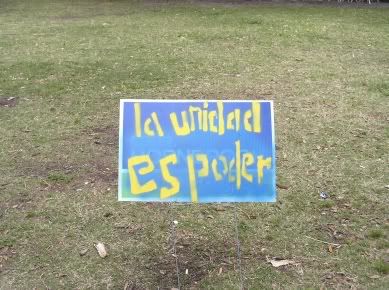
and from the writer's almanac:
Today is May Day, a celebration of the return of spring that goes back thousands of years in European traditions. Various May Day celebrations included the gathering of wildflowers and green branches, the weaving of floral garlands, and the setting up of a decorated May tree, or Maypole, around which people danced.
May Day never developed a Christian equivalent. In order to celebrate the holiday, workers had to stay home from work against their employers' wishes. It became known as a people's holiday, and in 1889, a congress of world Socialist parties held in Paris voted to choose May 1, 1890, as a day of demonstrations in favor of the eight-hour day.

and from the writer's almanac:
Today is May Day, a celebration of the return of spring that goes back thousands of years in European traditions. Various May Day celebrations included the gathering of wildflowers and green branches, the weaving of floral garlands, and the setting up of a decorated May tree, or Maypole, around which people danced.
May Day never developed a Christian equivalent. In order to celebrate the holiday, workers had to stay home from work against their employers' wishes. It became known as a people's holiday, and in 1889, a congress of world Socialist parties held in Paris voted to choose May 1, 1890, as a day of demonstrations in favor of the eight-hour day.
Saturday, April 29, 2006
L'unite Fait La Force!
Diverse Local Communities Bring National Movement To New Orleans
What: Diverse families and communities of New Orleans will unite on
Monday, May 1st, 2005 at 8:30 am at Congo Square in Louis Armstrong
Park. They will call for immigrant rights and a just reconstruction of
New Orleans. We are all human beings. No human being is illegal, said
Brenda Murphy, one of the organizers of the event. We want fair
treatment for all immigrants, workers, and families in New Orleans.
Organized by the Unity is Power Coalition, a group of community
organizations and concerned individuals, the event will link New Orleans
to the National Day of Action for Human Dignity and Immigrant Rights. In
line with the national actions and marches across the country, New
Orleans will proudly join in the call for immigrant rights.
Specifically, the local event proposes four points of unity
-Multi-racial Unity!
-Respect and Dignity for Workers!
-Immigrant Rights!
-The just and humane rebuilding of New Orleans!
Why: Thousands of immigrants live in the Greater New Orleans area and
the Gulf Coast. They are working hard to rebuild our great city. Yet
they face homelessness, toxic working environments, labor abuse and
barriers to medical care. The majority of the current workforce in NOLA
is left sick, cheated and living in extremely unsanitary conditions.
Immigrant workers often fall victim to predatory employers, are then
left with no recourse when they are injured or not paid for their work.
Similar rallies, marches and protests will be held across the country
to protest the draconian House Bill HR4437, which passed through the
House of Representatives and is up for vote in the Senate. The bill,
which criminalizes immigrants and people who help them, launched a
firestorm this year among immigrant families, and workers.
We rally and march on May 1st to call for respect and dignity for
immigrants and workers in the rebuilding of New Orleans!
When: May 1st, 2006 8:30am
Where: Congo Square in Louis Armstrong Park 801 North Rampart Street
Who: New Orleans Worker Justice Coalition
Diverse Local Communities Bring National Movement To New Orleans
What: Diverse families and communities of New Orleans will unite on
Monday, May 1st, 2005 at 8:30 am at Congo Square in Louis Armstrong
Park. They will call for immigrant rights and a just reconstruction of
New Orleans. We are all human beings. No human being is illegal, said
Brenda Murphy, one of the organizers of the event. We want fair
treatment for all immigrants, workers, and families in New Orleans.
Organized by the Unity is Power Coalition, a group of community
organizations and concerned individuals, the event will link New Orleans
to the National Day of Action for Human Dignity and Immigrant Rights. In
line with the national actions and marches across the country, New
Orleans will proudly join in the call for immigrant rights.
Specifically, the local event proposes four points of unity
-Multi-racial Unity!
-Respect and Dignity for Workers!
-Immigrant Rights!
-The just and humane rebuilding of New Orleans!
Why: Thousands of immigrants live in the Greater New Orleans area and
the Gulf Coast. They are working hard to rebuild our great city. Yet
they face homelessness, toxic working environments, labor abuse and
barriers to medical care. The majority of the current workforce in NOLA
is left sick, cheated and living in extremely unsanitary conditions.
Immigrant workers often fall victim to predatory employers, are then
left with no recourse when they are injured or not paid for their work.
Similar rallies, marches and protests will be held across the country
to protest the draconian House Bill HR4437, which passed through the
House of Representatives and is up for vote in the Senate. The bill,
which criminalizes immigrants and people who help them, launched a
firestorm this year among immigrant families, and workers.
We rally and march on May 1st to call for respect and dignity for
immigrants and workers in the rebuilding of New Orleans!
When: May 1st, 2006 8:30am
Where: Congo Square in Louis Armstrong Park 801 North Rampart Street
Who: New Orleans Worker Justice Coalition
Friday, April 21, 2006
the time has come, the time is now
the indyvoter guide to the new orleans elections
I'm really sick of the phrase "the world is watching."
the indyvoter guide to the new orleans elections
I'm really sick of the phrase "the world is watching."
Tuesday, April 11, 2006
they say everything can be replaced
I am never prepared for how painful it is to drive along the mississippi coast, where most of my family lives.
and here I have hundreds of mardi gras photographs that I have been meaning to post but this week I'm just not feeling it. the city elections are looming and my anxiety level is way up there. I'm trying to see opportunities shining in the wreckage but some days I fail. seems like today is one of those days.
meanwhile, here is this:
save the big easy
it's something.
I am never prepared for how painful it is to drive along the mississippi coast, where most of my family lives.
and here I have hundreds of mardi gras photographs that I have been meaning to post but this week I'm just not feeling it. the city elections are looming and my anxiety level is way up there. I'm trying to see opportunities shining in the wreckage but some days I fail. seems like today is one of those days.
meanwhile, here is this:
save the big easy
it's something.
Monday, March 20, 2006
dimanche gras
on the sunday before mardi gras, we marched with les enfants du nod. we were pirates.
my "rise up! new orleans" shirt was a key part of my costume.
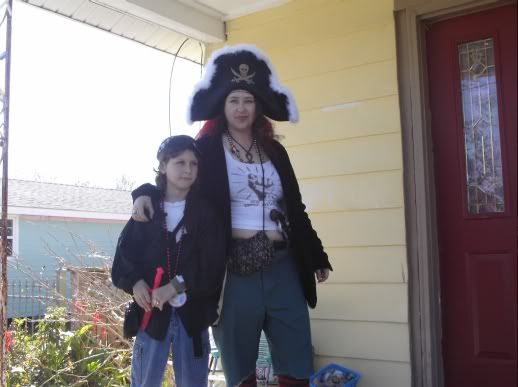

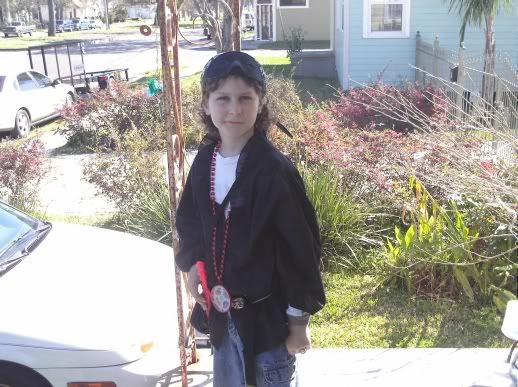

we mingled, and toasted...
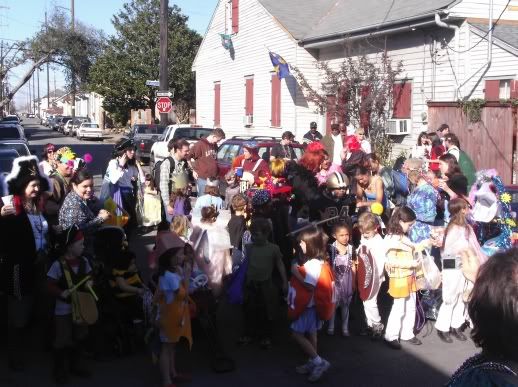
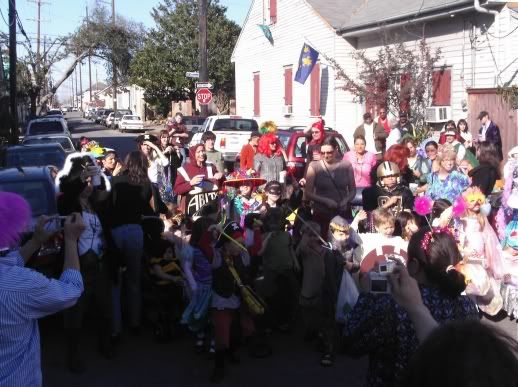
and then stepped off!

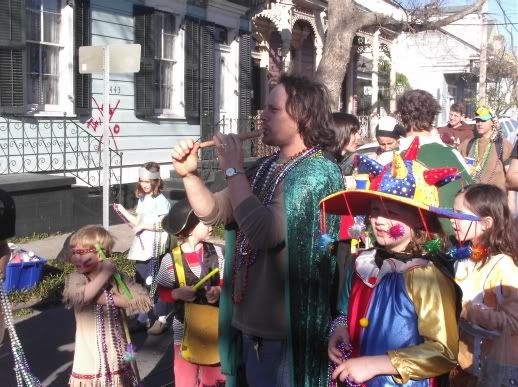
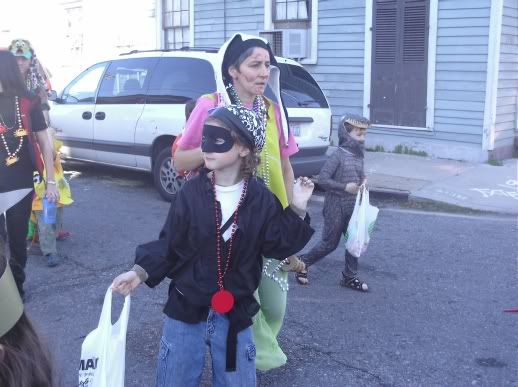
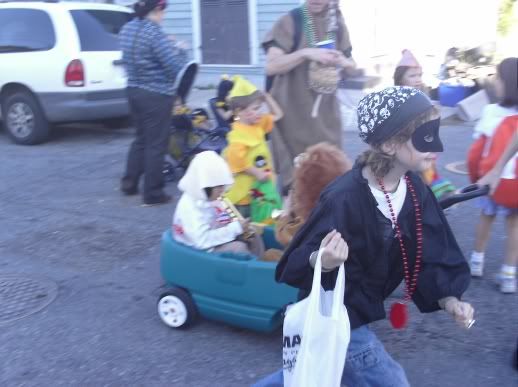
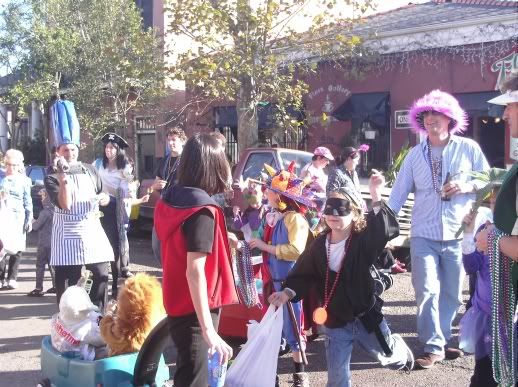

but once fatigue set in...
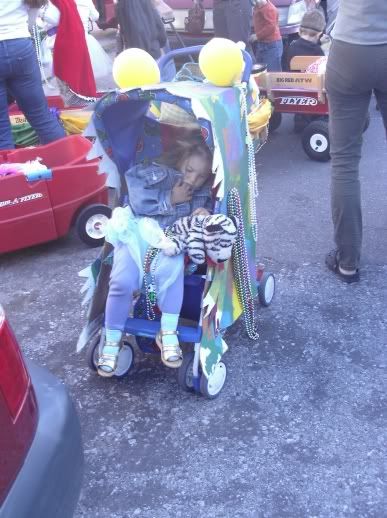
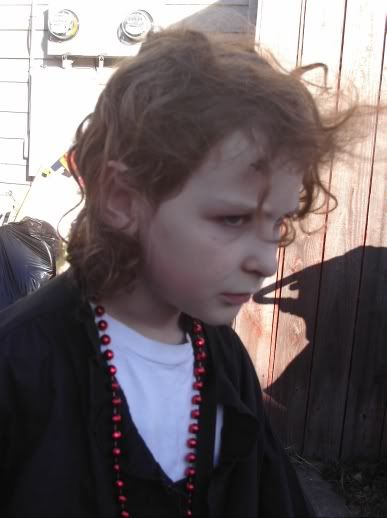


we said our goodbyes and headed for the ferry...
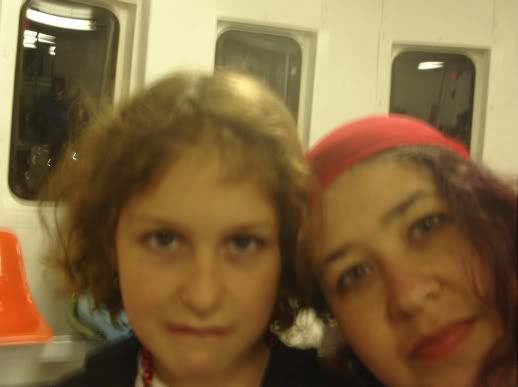

and home to bed!
stay tuned for tuesday photos.
on the sunday before mardi gras, we marched with les enfants du nod. we were pirates.
my "rise up! new orleans" shirt was a key part of my costume.




we mingled, and toasted...


and then stepped off!






but once fatigue set in...




we said our goodbyes and headed for the ferry...


and home to bed!
stay tuned for tuesday photos.
Thursday, March 09, 2006
the beginning of the look back
I wrote two mardi gras things for publication at once, and repeated myself a lot. here is the interview/story that my friend tom did with me -scroll down, it's the second feature.
I wrote two mardi gras things for publication at once, and repeated myself a lot. here is the interview/story that my friend tom did with me -scroll down, it's the second feature.
Tuesday, March 07, 2006
get your hustle on
mardi gras photos are coming, but first, check out this video filmed in the rubble of the 9th.
mardi gras photos are coming, but first, check out this video filmed in the rubble of the 9th.
Friday, February 24, 2006
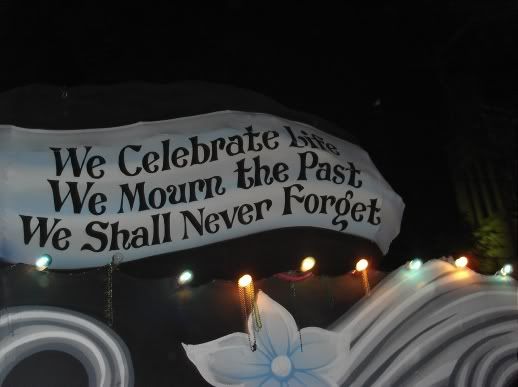
that picture - of the final float in the krewe of muses parade - says it all for me in terms of why we, the people of new orleans, continue to observe mardi gras even now.
here are some more images from my past week, which has been, aside from the regular work of, you know, work, pretty carnival-centric: going to parades and getting ready, gathering my costume gear, etc., in preparation for these next few days of revelry. conscious revelry.

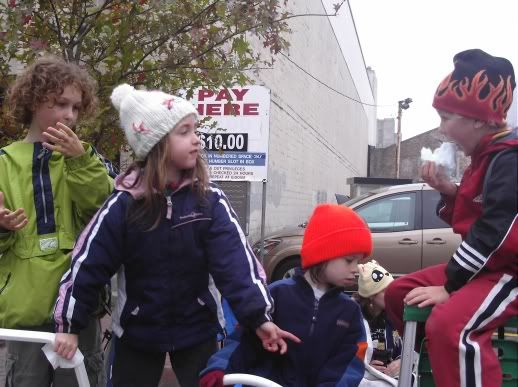
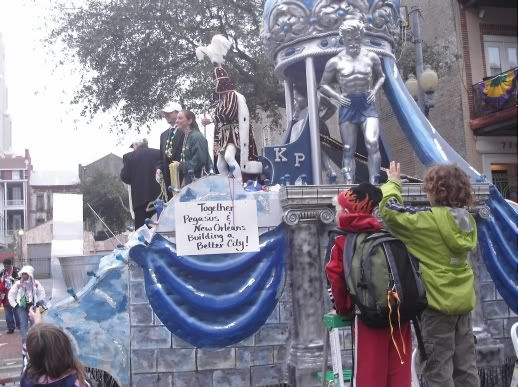
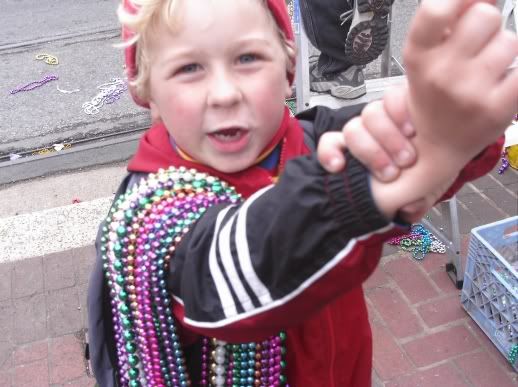
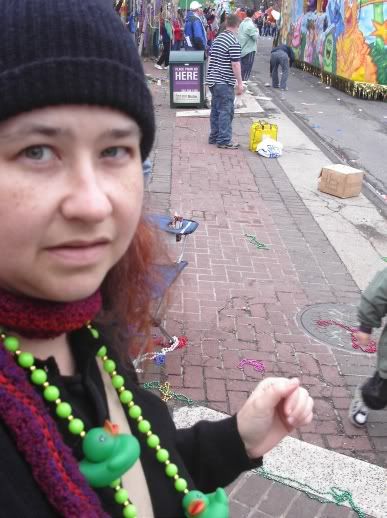
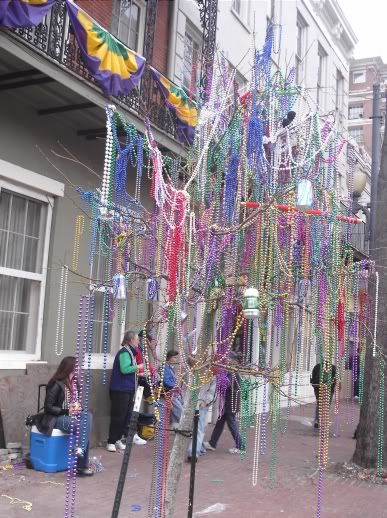
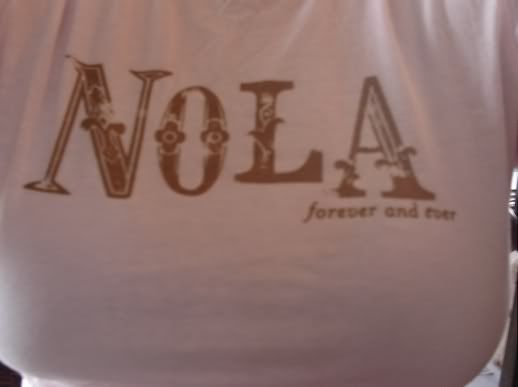
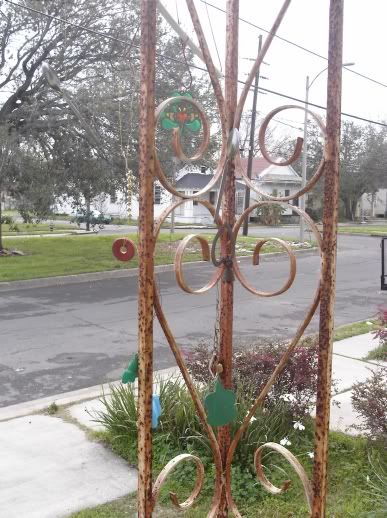



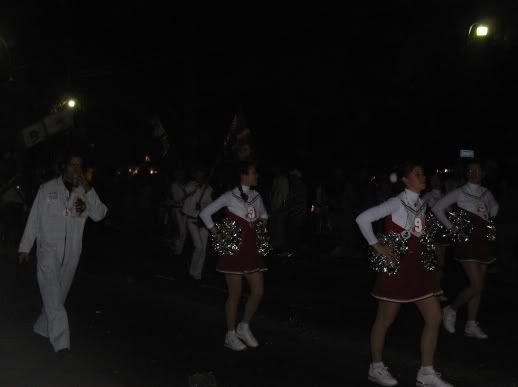
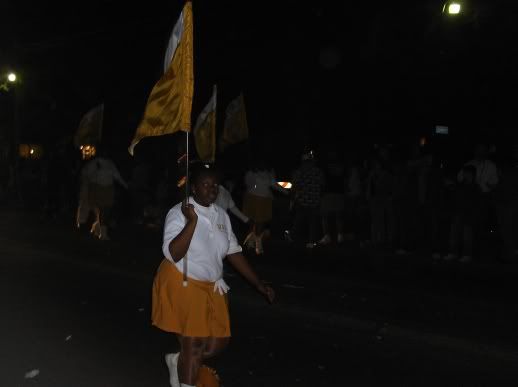
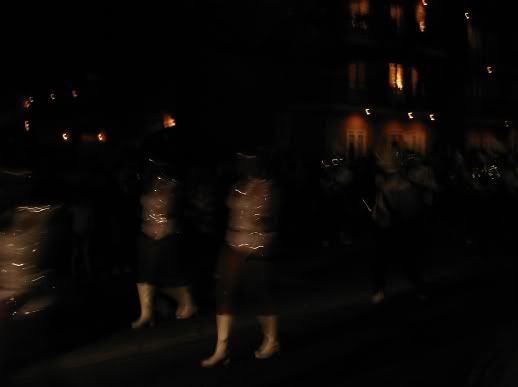
Subscribe to:
Posts (Atom)
